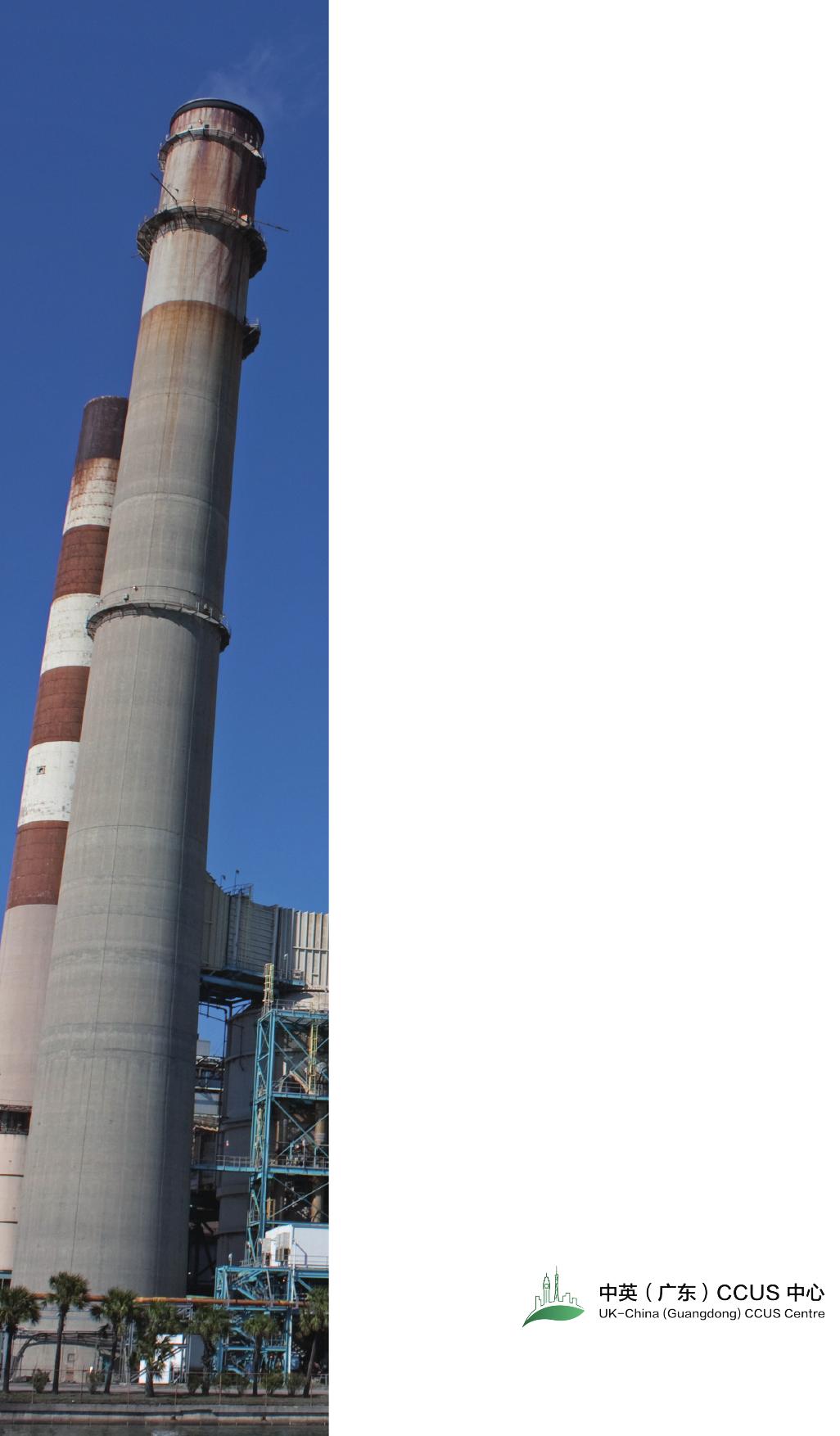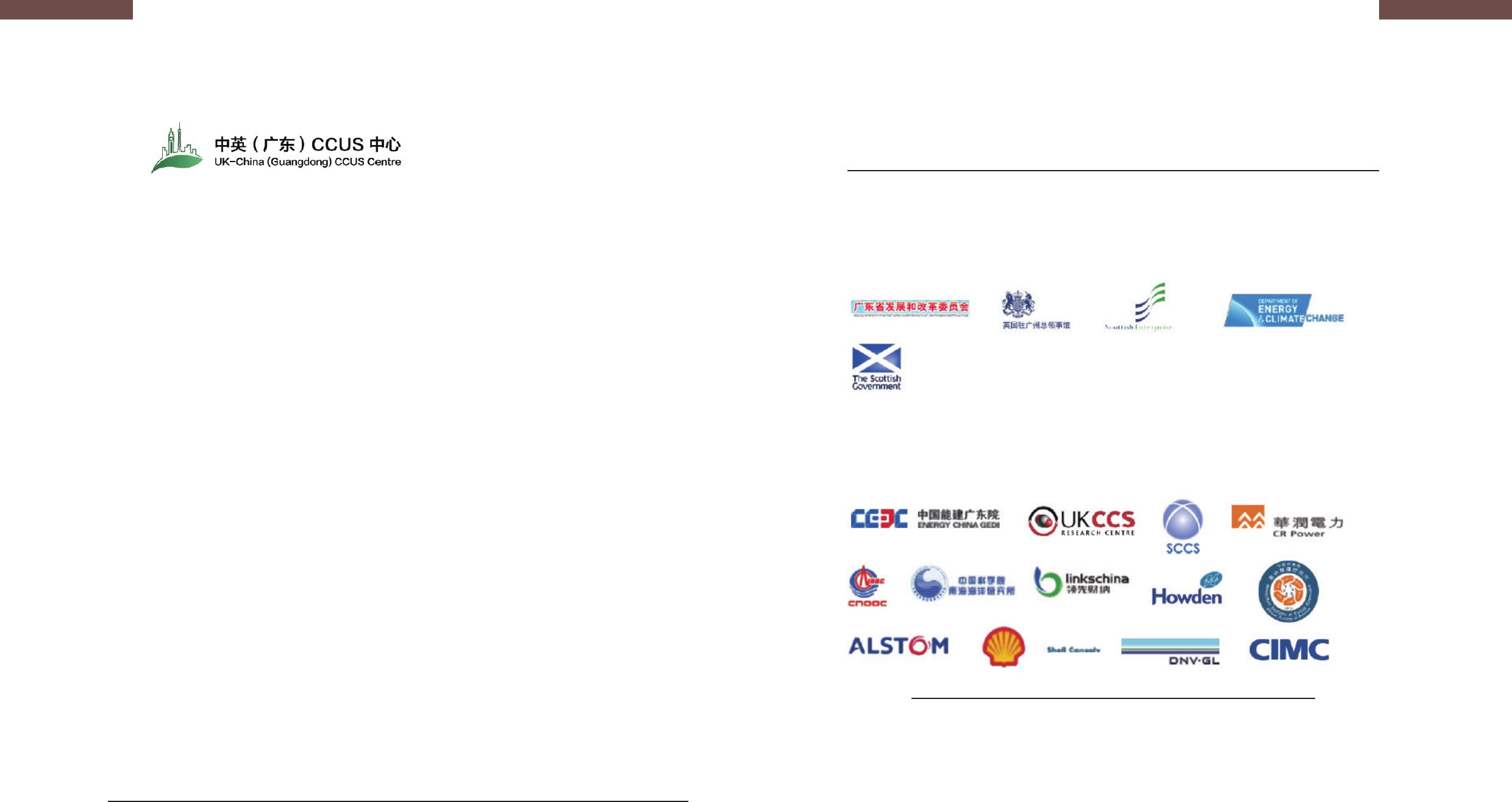GuangdongCO2UtilizationTechnicalReport广东省二氧化碳利用技术及潜力2014/D05讨论待修改稿DraftforDiscussionandFurtherRevision2009年,中国国务院提出2020年温室气体排放行动目标,并在2010年把广东省列为低碳试点省份。英国能源与气候变化部与广东省发展及改革委员会在广东省省长朱小丹的见证下于2013年9月在伦敦签订了推动低碳合作的联合声明,以深化双方合作,其中强调了开展碳捕集与封存(CCS)合作的重要性。2013年12月18日中英(广东)碳捕集,利用与封存产业促进与学术交流中心,即中英(广东)CCUS中心正式成立。中心致力于推动大型CCUS项目的示范,应对人类面临的温室气体排放的挑战,为中国面对的雾霾、水污染的问题提供国际合作平台,催化清洁化石能源技术产业化,以及培养相关专业人才。支持单位:中心发起机构:CCUSCCUSIn2009,China’sStateCouncilproposedits2020goalforgreenhousegasemissions,andthenin2010madeGuangdongalowcarbonpilotprovince.GuangdonghasmaderemarkableachievementsingreenhousegasemissioncontroltowhichtheUK-Chinalowcarboncooperationhascontributedsignificantly.InSeptember2013theUKDepartmentofEnergyandClimateChange(DECC)signedajointstatementinLondonwiththeGuangdongDevelopmentandReformCommission,witnessedbygovernorZhuXiaodanofGuangdongProvince,tostrengthenlowcarboncooperation.ThejointstatementhighlightstheimportanceofcollaboratinginCarbonCaptureandStorage(CCS).SupportedbytheGuangdongandUKgovernments,theUK-China(Guangdong)CarbonCapture,UtilisationandStorageIndustryPromotionandAcademicCollaborationCentre(the“Centre”)wasofficiallyfoundedonDecember18th,2013.TheCentreiscommittedtopromotingthedemonstrationoflarge-scaleCCUSprojectstotacklegreenhousegasemissions.Atthesametime,theCentrewillalsoprovideaninternationalcollaborationplatformforsolutionstootherlocalpollutionproblems(suchashaze,waterpollution)causedbycoalutilization,andtoacceleratetheindustrializationforcleanfossilenergytechnologiesandtotrainqualifiedprofessionals.SUPPORTINGINSTITUTESFOUNDINGMEMBERSAcknowledgements&DisclaimerThisreportisjointlyproducedbyMs.YiChen,Mr.TiejunZhangandMs.YutongShu,researchersoftheUK-China(Guangdong)CCUSCentreandstudentsatTheUniversityofEdinburgh,Dr.XiLiang,SeniorLectureratTheUniversityofEdinburghandSecretaryGeneraloftheUK-China(Guangdong)CCUSCentre,ProfLiPengchunatSouthChinaSeaInstituteofOceanology(SCSIO),andProfWeiNingfromInstituteofRockandSoilMechanics(IRSM),ChineseAcademyofSciences.OurdeepestgratitudegoesfirstandforemosttoProfessorDiZhou,deputychairoftheadvisoryboardofUK-China(Guangdong)CCUSCentreandresearcherintheSouthChinaSeaInstituteofOceanology,ChineseAcademyofSciences,forherefforttobuildacommunicationplatformforCO2utilizationtechnologiesandtoprovidesomeofthetechnicalmaterialsforthisreport.WewouldalsoliketoexpressourheartfeltgratitudetoProf.WenzhouXiangandDrTaoLifromSouthChinaSeaInstituteOfOceanology,ChineseAcademyofSciences,Prof.YuezhongMengfromSunYat-SenUniversity,Prof.XiaochunLifromInstituteofRockandSoilMechanics,ChineseAcademyofSciences,andDr.DongLiufromGuangdongElectricPowerDesignInstituteforthetechnicalresearchmaterialstheyprovided.ThankstoMrBillSeniorforreviewingthereport.SpecialthankstosupportbyGuangdongDevelopmentandReformCommissionandBritishConsulateGeneraltoGuangzhouforsupporttheproject.YiChen1,2,TiejunZhang1,2,YutongShu,XiLiang1,2,PengchunLi1,3,NingWei1,4(1UK-China(Guangdong)CCUSCentre,Guangzhou,China,2UiniversityofEdinburgh,Edinburgh,UK,3SouthChinaSeaInstituteofOceanology,ChineseAcademyofSciences,4InstituteofRockandSoilMechanics,ChineseAcademyofSciences)Acknowledgements&Disclaimer致谢与声明致谢与声明本报告由中英(广东)CCUS中心秘书长、爱丁堡大学梁希副教授,中英(广东)CCUS中心实习生、爱丁堡大学研究生陈弋女士和张铁骏先生,以及舒宇彤女士,中科院南海海洋研究所李鹏春教授,中科院武汉岩土所魏宁共同编写。特别感谢中英(广东)CCUS中心顾问委员会副主席、中科院南海海洋研究所周蒂教授对二氧化碳利用技术交流平台的搭建以及对部分技术总结材料的提供。感谢中国科学院南海海洋研究所向文洲教授和李涛博士,中山大学孟跃中教授,中科院武汉岩土力学研究所李小春教授和广东省电力设计研究院刘东博士为相关技术提供总结材料。感谢BillSenior先生对报告的审阅和建议,感谢叶碧涵女士协调报告的排版和美工。感谢广东省发改委和英国领事馆对项目的支持。陈弋1,2,张铁骏1,2,舒宇彤2,梁希1,2,李鹏春1,3,魏宁1,4(1中英(广东)CCUS中心;2爱丁堡大学,爱丁堡,英国;3中科院南海海洋所;4中科院武汉岩土所)目录1.引言11.1CO2利用技术简介11.2当今政策环境下CO2利用技术的意义31.3本报告的研究方法及结构42.第2章传统商业化CO2利用技术62.1传统CO2利用技术介绍62.2CO2商业化应用的市场供求概况83.第3章CO2地质利用技术153.1CO2驱油技术153.2CO2增强地热系统技术224.第4章创新型CO2利用技术264.1CO2合成可降解塑料264.2CO2合成汽油添加剂294.3微藻养殖耦合CO2减排技术314.4太阳光催化转化CO2技术365.结论与讨论39参考文献43目录1.Introduction11.1BriefintroductiontoCO2utilizationtechnologies11.2ThesignificanceofCO2utilizationtechnologiesundercurrentpolicysettings41.3Methodologyandstructureofthereport52.TraditionalcommercialCO2utilizationtechnologies62.1IntroductiontotraditionalcommercialCO2utilizationtechnologies62.2MarketsupplyanddemandsituationofcommercialCO2utilization83.GeologicalCO2utilizationtechnologies153.1CO2EnhancedOilRecovery(CO2-EOR)153.2CO2EnhancedGeothermalSystems(CO2-EGS)224.InnovativeCO2utilizationtechnologies264.1CO2syntheticbiodegradableplastics264.2CO2syntheticgasolineadditives294.3MicroalgaeculturingcouplingCO2emissionreductiontechnology314.4SolarcatalyticconversionofCO2365.ConclusionandDiscussion39References43ContentsContent1.引言Introduction211.1CO2利用技术简介近年来,气候变暖已严重威胁到人类可持续发展,应对气候变化成了全球共同面临的重大挑战。政府间气候变化专门委员会(IPCC)评估报告指出大气中CO2浓度的增加是气候变化的最大推手(IPCC,2013)。原则上,至少有三种方法可以减少大气中CO2:在源头减少CO2排放;CO2的捕获、封存(CCS);CO2的利用(Wangetal.,2014)。其中,对已经产生的CO2进行捕集与封存已经逐渐被公认为一项可以实现CO2大规模减排的方法,然而这项措施目前还存在着成本高,部分地区缺乏封存能力有不确定性等局限(SridharandHill,2011),制约着CCS技术的应用和发展。CO2的利用技术可以作为一个过渡方案,将捕集到的CO2附加价值,带来经济效益,补偿CCS的成本,逐渐受到人们的关注。目前,尚未有成熟的利用技术能够为人类大幅度减排二氧化碳。除了二氧化碳提高石油采收率等地质利用,其他利用能够经济地减排二氧化碳量非常有限。具体来说,通过对排放的CO2回收利用至少可从四种途径缓解气候变化问题(Aresta,2010;AudusandOonk,1997):一是二氧化碳的地质利用,如提高石油采收率,提高水的采收率;二是通过对CO2的利用直接减少CO2的排放,例如以CO2为原料生产化工商品;三是通过将CO2重新还原为碳氢燃料(例如,微藻养殖生成柴油技术等),循环对碳原子的利用,减少其它来源的化石燃料的燃烧,最终减少CO2的排放;四是通过开发新的反应路径以CO2为反应试剂替代传统对气候变化有更大影响的物质,间接地缓解气候变化问题,例如在干洗业,用液体CO2替代氯化物溶剂(相同质量情况下,氯化物造成全球暖化的能力是CO2的数百至数千倍)。Sridhar教授估计,理论上,如果各种CO2利用技术得到广泛应用,可通过前2种途径减少至少3.7Gt/y的CO2向大气中的排放(相当于现在每年排放CO2的10%)(Sridharetal.,2011)。需要注意的是,即使CO2利用技术可以得到广泛地应用,它的减排潜力也是很有限的,且并不能有效抑制大气中CO2的积累,只可以减少CO2的向大气中的排放(Aresta,2010)。尤其在现阶段,典型的利用技术中CO2被利用的周期只有数天到数月,被利用的CO2储存在工业产品中,很快又会被分解、释放到大气中,很难起到减排的效果(Mikkelsenetal.,2010)。另外,一些转化过程需要消耗能源,可能会导致CO2的排放,而许多较有减排潜力(对CO2固定时间长,能耗小)的利用技术还处于R&D或者示范阶段,未能扩大规模充分发挥减排作用。除此之外,CO2技术的发展也受到多种因素的制约(Song,2010):(1)CO2的捕集、纯化、运输费用高;(2)一些CO2的化学转化需要消耗大量能量;(3)市场相对较小,缺乏投资激励;(4)缺乏发展CO2利用技术社会经济推动力。尽管CO2利用技术的直接减排作用小,且受到多种因素的制约,发展缓慢,CO2利用技术仍是应对气候变化问题的潜在重要措施。国际社会已经开始对CO2利用技术进行积极探索和发展。美国政府已经投资10亿美元于CO2的捕集和利用的研究;德国政府仅对一个利用CO2作为原材料的项目就投资了1.18亿欧元(Styringetal.,2011)。中国政府早就有对CO2利用相关技术开发利用的扶持,但从缓解气候变化问题的引言1.1BriefintroductiontoCO2utilizationtechnologiesThesustainabledevelopmentofhumanbeingshasbeengreatlythreatenedbyglobalwarming,andtheworldisconfrontedwithabigchallengetotackleclimatechange.TheassessmentreportpublishedbytheIntergovernmentalPanelonClimateChange(IPCC)indicatedthattheincreaseofCO2concentrationintheatmosphereisthebiggestdriverofclimatechange(IPCC,2013).Inprinciple,thereareatleastthreewaystoreduceCO2intheatmosphere:CO2emissionreductionfromsource;CO2captureandstorage(CCS);andCO2utilization(Wangetal.,2014).Amongstthese,CO2captureandstorageisrecognizedasatechnologythatcanrealizedrasticemissionreductions,thoughitsdeploymentanddevelopmentisconstrainedduetoitsrelativelyhighcostandlimitofCO2storageincertainregions(SridharandHill,2011).CO2utilizationtechnology,however,asapotentialtransitionmechanism,isgraduallyattractingpeople’sattentionbecauseitcanaddvaluetothecapturedCO2,bringingeconomicbenefitsandcompensatingforthecostofCCS.Sofar,thereisnotyetamatureutilizationtechnologythatcouldcontributetoadeepcutofgreenhousegasemissionsofhumanbeing.ApartfromCO2utilisationthroughgeologicalutilizationsuchasenhancedoilrecovery(EOR),otherutilizationmethodscouldonlyreduceorconsumeverylimitamountofCO2comparedtothetotalamountofanthropogenicemissions.Indetail,therearefourpathwayswhichhelpmitigateclimatechangeissuebyreusingrecoveredCO2(Aresta,2010;AudusandOonk,1997):1.CO2geologicalutilization,suchasenhanceoilrecovery(EOR),enhancewaterrecovery(EWR).2.CO2utilizationcandirectlycutCO2emissionstotheatmosphere.forexample,CO2areconvertedtoindustrialchemicalsand“stored”insuchproducts;3.TheCO2canbereducedtohydrocarbonfuelsthroughsomeutilizationtechnologies(suchasmicroalgaebreedingcoupledwithCO2emissionreductiontechnology),bywhichcarbonisrecycled,thereforereducingorreplacingtheuseoffossilfuels,andindirectlyreducingCO2emissions.4.BydevelopingnewreactionpathswithCO2asthereactionreagenttoreplacetraditionalchemicalswhichhasgreaterinfluenceonclimatechange,CO2utilizationmayhaveanindirectcontributiontomitigatingclimatechange.Forexample,inthedrycleaningindustry,chlorinatedsolventandcongenersaresubstitutedwithliquidCO2(withthesamemass,chloridehasaclimatechangepowermanythousand-foldthatofCO2)Itisestimatedthatatheoreticalpotentialof3.7GtCO2couldbepreventedfromenteringtheatmosphereeveryyearthroughthefirsttwopathways(accountingfor10%oftheannualtotalCO2emission)(Sridharetal.,2011)Itshouldberememberedthat,eveniftheCO2utilizationtechnologycanbewidelyused,itsemissionsreductionpotentialislimited.TheuseofCO2willnotsolvetheChapter134视角专门对CO2利用技术进行评估、总结和支持还是近些年的事。需要提出的是本报告中CO2利用技术既指利用化学和生物的方法将CO2转化为其它分子形态的物质并从而带来附加价值的技术,也指利用CO2自身的物理化学性质协助或强化其他过程(有时可以同时将CO2封存)的技术。特别需要注意的是,在实际发展CO2利用技术的过程中,需要对技术进行综合的评估,包括整个生命周期过程中的减排潜力,能耗,环境影响,成本,原料等(Singhetal.,2014;Angunnetal.,2014;),同时还需根据CO2利用技术对地理位置,CO2利用规模与纯度的要求,选择与相当的CO2排放源相结合,以实现真正的减排或其它社会经济收益。由于时间和专业知识的限制本报告仅对广东省几个典型的CO2利用技术进行初步的介绍和分析。改革委员会于2011年10月底,批准7省市开展碳排放权交易试点工作。广东省作为7省市之一于2013年11月正式启动碳交易市场。与此同时,国家发改委和科技部在推动CCUS技术和政策文件均强调二氧化碳利用的重要性。在此政策环境和趋势下,可以同时兼顾经济和社会效益的CO2利用技术的优势将越来越明显。这是因为,一方面CO2利用技术是COCO22潜在的“汇”,这意味着CO22技术的收益可能会增加,而另一方面碳市场的建立如果推动了CCS的发展,CO2利用技术作为是弥补CCS高成本的一项方法,也可能会得到进一步的促进,但目前尚不清楚碳市场能够支持哪种利用技术。problemofatmosphericCO2accumulation,itmightcontributetosuchanissuebyreducingthevolumeofCO2produced(Aresta,2010).EspeciallyatpresentthetypicallifetimeoftheCO2currentlyusedinchemicalapplicationsisonlydaystomonths.ThestoredcarbonisthendegradedtoCO2againandemittedintotheatmosphere.WithsuchshortlifetimesitisdifficulttocontributesignificantlytothemitigationoftheCO2problembytheindustrialutilizationofCO2(Mikkelsenetal.,2010).Inaddition,someconversionofCO2consumelargeamountofenergy,whichmayintroducenewCO2emissions,andmanyCO2utilizationtechnologieswithpromisingpotentialtoreduceemissionsarestillintheR&Danddemonstrationstage,andhavenotbeenabletobeappliedonthelargescale.Whatisworse,thebarriersforCO2utilizationinclude(Song,2010):(1)costsofCO2capture,separation,purification,andtransportationtousersite;(2)energyrequirementsofCO2chemicalconversion(plussourceandcostofco-reactants);(3)marketsizelimitations,littleinvestment-incentivesandlackofindustrialcommitmentsforenhancingCO2-basedchemicals;and(4)thelackofsocio-economicaldrivingforces.DespiteCO2utilizationtechnologyleadstolimitedCO2emissionreduction,anditsdevelopmentisrestrictedbymanyfactors,itisanimportantmeasurestotackleclimatechange.CO2utilizationtechnologyhasbeenactivelyexploredanddevelopedthroughouttheworld.TheU.S.Governmenthasinvested1billionUSdollarsinresearchintoCO2captureandutilization;Germanyspent118millioneurosononeprojectusingCO2astherawmaterialswith(Styringetal.,2011).ThedevelopmentanddeploymentofCO2utilizationtechnologyhavelongbeensupportedbytheChinesegovernment,whiletheassessment,supportandconclusionsconcerningCO2utilizationtechnologyfromtheperspectiveofmitigatingclimatechangeonlystartedinrecentyears.PleasenotethattheCO2utilizationtechnologiessetoutinthisreportrefernotonlytousingchemicalandbiologicalmethodstoconvertCO2intoothermoleculesandthusbringadditionalvalueoftechnology,butalsousingthechemicalandphysicalpropertiesofCO2toassistorstrengthenotherprocesses(sometimesinvolvingCO2storageatthesametime).Itshouldbenotedthat,inrealpractices,beforedevelopingCO2utilizationtechnologies,thetechnologiesshouldbeevaluatedcomprehensively,includingtheemissionreductionpotential,energyconsumption,environmentalimpact,thecostandrawmaterialsetc.intheentirelifecycle(Singhetal.,2014;Angunnetal.,2014);Atthesametime,inordertorealizetherealemissionreductionandothersocialandeconomicbenefits,itisbettertomatchthespecificCO2utilizationtechnologiesapplicationswithappropriateCO2emissionpointsorCCSinfrastructuresbasedonitslocation,scaleandpurityofemittedCO2.Becauseofthelimitationoftimeandknowledge,thisreportwillonlycarryonthepreliminaryintroductionandanalysisoftypicalCO2utilizationtechnologiesinGuangdongprovince.1.2当今政策环境下CO2利用技术的意义近些年来,中国一直努力推进低碳经济,循环经济以及二氧化碳的减排工作。2008年通过的《循环经济促进法》积极推进资源利用减量化、再利用、资源化,从源头和生产过程减少温室气体排放(LiandWu,2014)。CO2利用技术可以将温室气体资源化,是促进循环经济和减排的典型技术。随着全球对气候变化问题的日益重视,中国也加紧了对CO2的控制。在2009年的哥本哈根峰会上,中国承诺于2020将CO2排放强度较2005年减少40%-45%。而现阶段,“十二五规划纲要”规定国家在2011-2015期间减少17%的排放强度(YanandFang,2015)该纲要还明确提出逐步建立全国碳排放交易市场,使控制温室气体排放从单纯依靠行政手段逐渐向更多地依靠市场力量转化(Zheng,2014)。为此国家发展和1.3本报告的研究方法及结构本报告通过现场调查、访问专家和文献收集的方法对广东省CO2利用技术进行了调查和总结,并根据技术发展的阶段(基础研究,技术研发,中试,示范,工业化)对未商业化的技术的成熟度进行评估,同时从减排潜力等其他方面对技术进行综合评价。本报告共分为5章。第1章主要对CO2利用技术进行简单的介绍并分析其在当今政策环境下的重要意义。本报告的主体部分对广东省典型的CO2利用技术的进行了介绍和总结。这些技术根据商业化程度、学科领域和创新度差异分以下三章进行描述:商业化CO2利用技术(第2章),CO2的地质利用技术(第3章)以及创新型CO2利用技术(第4章)。其中第2章着重对CO2商业化应用的市场供求情况进行了介绍。第3、4章则主要从技术本身、技术成熟度和发展潜力方面进行阐述。最后,第5章将对未商业化的技术进行了成熟度进行比较,结合技术特点试揭示出不同技术在广东省的发展潜力。1.2ThesignificanceofCO2utilizationtechnologiesundercurrentpolicysettingsChinahasbeenworkingforsometime引言Chapter156Chinahasbeenworkingforsometimeonalowcarbonandcirculareconomy,andCO2emissionreduction.The"CircularEconomyPromotionLaw"passedin2008activelypromotesthereduceduse,reuseandrecyclingofresources,reducinggreenhousegasemissionsfromthesourceandtheproductionprocess(LiandWu,2014).CO2utilizationtechnologyisatypicalmethodtoboostthecirculareconomyandemissionreductionatthesametimeasutilizinggreenhousegasesasaresource.Chinesegovernmenthasputstrongereffortongreenhousegascontrol.Duringthe2009CopenhagenSummit,ChinacommittedtoreduceitsCO2emissionsintensityby40%-45%overthe2005-2020period.Mostrecently,China’s12th22FYPsetanationaltargetforreducingCO2emissionintensityby17%overthe2011-2015period(YanandFang,2015).TheOutlinealsoclearlyputforwardtheintentiontobuildanationalcarbonemissionstradingmarket,topushforthetransitionfromrelyingpurelyonadministrativepowertocontrolgreenhousegasemissionstograduallyrelyingmoreonmarketforces(Zheng,2014).ConsequentlytheNationalDevelopmentandReformCommitteeapproved7provincesandcitiestocarryoutcarbonemissionstradingpilotwork.Guangdongprovince,asoneoftheseprovinces,startedacarbontradingmarketinNovember2013.Inaddition,bothNDRCandMinistryofSciencesandTechnologyhighlightedtheroleofCO2utilizationinpromotingCCUStechnologiesanddemonstrationprojects.Withthesepolicybackground,theadvantageofCO2utilizationtechnologywhichcanbringbotheconomicandsocialbenefitsisbecomingmoreandmoreobvious.BecausetheapplicationofCO2utilizationtechnologiesisapotential“sink”ofCO2,whichmaybringadditionalprofittosuchpractice.Inaddition,ifthecarbonmarketcanpromotethedevelopmentofCCS,CO2utilizationtechnologiesmayalsobepopularizedsincethesecanhelpmitigatethehighcostofCCS,althoughitisstillunclearwhichCO2utilisationtechnologywouldbequalifiedforsupportfromthecarbonmarket.1.3MethodologyandstructureofthereportThisreportinvestigatesandsummarizesCO2utilizationtechnologyinGuangdongprovincethroughfieldinvestigation,visitingexperts,andliteraturereview.Itevaluatesthematurityofthosetechnologieswhicharenotcommercializedaccordingtothetechnologydevelopmentphase(thevariousphasesareusuallyacknowledgedasbasicresearch,technologyresearchanddevelopment,pilottest,demonstration,industrialization),andatthesametimecomprehensivelyevaluatesthetechnologiesinrelationtotheiremissionsreductionpotentialandotheraspects.Thisreportisdividedintofivechapters.Chapter1makesabriefintroductiontoCO2utilizationtechnologiesandanalyzestheirsignificanceundertoday'spolicyenvironment.ThemainbodyofthereportintroducesandsummarizesthetypicalCO2utilizationtechnologiesinGuangdongprovince.Thesetechnologiesaredescribedaccordingtothelevelofcommercialization,disciplineanddifferentlevelsofinnovationinthefollowingthreechapters:commercialCO2utilizationtechnology(Chapter2),CO2geologicalutilizationtechnology(Chapter3),aswellasinnovativeCO2utilizationtechnology(Chapter4).Chapter2mainlydealswithmarketsupplyanddemandforcommercialCO2utilization.Chapter3and4mainlyexplainthetechnologiesthemselves,technicalmaturityandtheirdevelopmentpotential.Finally,Chapter5comparesthematurityofthosetechnologiesthatarenotcommercializedandindicatestheirpotentialinGuangdongbasedontheircharacteristics.2.1.1TechnologyIntroductionCO2,asaresource,hassomeimportantphysicalandchemicalproperties.CO2gasisodorlessatlowconcentration,butitsacidicsmellinrelativelyhighconcentrationcancausesuffocationandirritation.Understandardtemperatureandpressure,thedensityofCO2isabout1.98kg/m3,1.67timesthatofair.TheCO2willsublimateatminus78.51°C,andsolidCO2iscommonlyknownas"drikold"or“dryice”whichisusuallyusedforfreezing.Dryicewillgasifyatroomtemperatureatthesametimeabsorbingalargeamountofheat.CO2hasadoublemolecularbondwithtwooxygenandacarbonatom,itsstructureisstable,anditischemicallyinert,non-ignitableandnon-toxicwithoutflashpoints.CO2isnecessaryforthephotosynthesisofplants.LiquidandsupercriticalCO2canbothbeusedasasolvent,andthelatterhasahighersolubilitythantheformer(itsdensityandhighsolubilityareclosetoliquid,anditisalsooflowviscosityandhighpenetration),butitrequiresmorehandlingequipmentthanliquidCO2.ThetraditionaluseofCO2ismainlybasedonitschemicalandphysicalproperties,andthetheoryisrelativelysimple.ThetablebelowshowsthephysicalandchemicalpropertiesofCO2andtheircorrespondinguses.2.传统商业化CO2利用技术TraditionalCommercialCO2UtilizationTechnologies2.1.1技术简介CO2作为一种利用资源具有一些重要的物理化学性质。在低浓度时,CO2气体是无味的,但在较高浓度时会有酸性气味,它可造成窒息和刺激。在标准的温度和压力下,CO2的密度大约是1.98kg/m3,是空气的1.67倍。-78.51°C时,CO2会凝华,固态CO2俗称“干冰”,一般用作冷冻。固态的CO2(或干冰)在常温下会气化,同时吸收大量的热。CO2用两个氧原子与一个碳原子以双键组成,结构很稳定,化学性质不活泼,没有闪点,不燃,无毒性。CO2是植物进行光合作用必须的原料。液体CO2和超临界CO2均可作为溶剂,超临界CO2具有比液体CO2更高的溶解性(具有与液体相近的密度和高溶解性,并兼备气体的低粘度和高渗透力),但它对设备的要求比液体CO2高。对CO2的传统利用主要基于CO2本身的物理化学性质,原理相对简单,下表为CO2的物理化学性质与对应的利用方式。2.1传统CO2利用技术概述IntroductiontoTraditionalCommercialCO2UtilizationTechnologiesChapter2引言78性质应用较高浓度有窒息和刺激性抑制细菌,食品保鲜,酿酒密度大约是空气的1.67倍,且不助燃灭火分子结构稳定,化学惰性焊接时的保护气体固态CO2(干冰)升华放热制冷剂植物光合作用原料植物气肥无色无臭;水溶液呈弱酸性,可缓冲溶液饮料充气添加剂液体CO2气化膨胀烟丝膨胀剂液体CO2和超临界CO2高溶解性清洗、萃取剂PropertiesUsesCausesuffocationandirritationinhighconcentrationBacteriaconstraint,foodpreservationandwineorbeerproductionItsdensityisabout1.67timesthatofair,anditdoesnotsupportburningFireextinctionItsmolecularstructureisstable,anditischemicallyinertWeldprotectionSolidCO2(drikold)releasesheatduringsublimationRefrigerantRawmaterialsforphotosynthesisofplantsAirfertilizerColorless,odorless,weaklyacidic,buffersolutionBeveragefillingadditivesDilationduringCO2gasificationofliquidCO2TobaccoshredswellHighsolubilityofliquidCO2andsupercriticalCO2Detergentandextractant表2.1CO2的物理化学性质与对应的利用方式(Zhang,2003;Shietal.,2006)Table2.1ThePhysicalandChemicalPropertiesofCO2andtheirCorrespondingUtilizationApplications(Zhang,2003;Shietal.,2006)2.1.2传统CO2应用行业分布CO2的物理和化学应用主要集中在工业级(纯度>99.0)和食品级(纯度>99.9)两个方向。总体上说工业级中应用包括:(1)二氧化碳气体保护焊接;(2)制冷剂(汽车空调制冷剂,干冰研磨清洗);(3)消防气体;(4)固化硬化剂;(5)超临界萃取和超临界清洗剂;(6)植物气肥。食品级的主要应用行业有:(1)饮料行业;(2)啤酒行业;(3)烟草行业;(4)食品保鲜。这些传统的CO2利用技术大多对CO2的存储时间在几天到几个月间不等,存储时间较长的为植物气肥。需要注意的是,由于大多是的传统利用技术并没有转化CO2,一旦应用,CO2就释放到了大气中,因而对CO2的实际存储量主要在于存货量而不在于产量。2.2.1中国CO2市场供求现状2.2.1.1价值链如图2.1所示,中国较为典型的二氧化碳市场价值链主要分为供应商、中间商和最终需求方3个环节。2.1.2IndustrialdistributionoftraditionalCO2utilizationPhysicalandchemicalapplicationsofCO2mainlyincludeindustrialgrade(purityhigherthan99.0%)andfoodgrade(purityhigherthan99.9%).Ingeneral,industrialapplicationsinclude:(1)CO2gasshieldedwelding;(2)refrigerant(automobileairconditioningrefrigerants,grounddryicecleaning);(3)fireextinguishers;(4)curingagent;(5)supercriticalfluidextractionandsupercriticaldetergent;(6)airfertilizerforplants.Foodgradeapplicationsaremainlyin:(1)beverageindustry;(2)beerindustry;(3)tobaccoindustry;(4)foodpreservation.MostofthesetraditionalCO2utilizationtechnologiescouldonlystoreCO2forafewdaystoafewmonths,airfertilizerforplantcankeepCO2capturedandstoredinarelativelylongtime.Itshouldbe2.2.1MarketsupplyanddemandstatusofCO2inChina2.2.1.1ValuechainAsshowninfigure2.1,China'stypicalofcarbonmarketvaluechainincludessuppliers,intermediariesandthefinalconsumer.notedthatsincemosttraditionalutilizationtechnologiesinvolvenoconversionofCO2,oncetheyaretheapplied,CO2isreleasedintotheatmosphere,thusfortheactualstorageoftheCO2mainlydependsontheamountofstockratherthanproduction.2.2CO2商业化应用的市场供求状况MarketsupplyanddemandstatusofcommercialCO2utilization第二章Chapter2910图2.1二氧化碳市场价值链图2.2凯美特二氧化碳生产成本Figure2.1CO2marketvaluechain2.2.1.2供应商与成本分析目前中国二氧化碳制造行业刚刚起步,业内约100多家生产企业可分为三类:第一类为自建二氧化碳回收设备的化工企业,如化肥厂、酒精厂等,这类企业主要利用自身的工业废气,通常规模较小,仅万吨左右,但数量较多;第二类为自建二氧化碳回收设备的大型化工集团下属公司,如中石化广州分公司华达气体厂,这类企业可利用集团下多个子公司废气资源,逐个复制二氧化碳回收模式,虽现阶段规模较小,但有依托集团成长为大规模的潜力。目前仅中石化、中海油下的几个公司有此类业务;第三类为以二氧化碳为主营业务,采购废气进行生产的专业二氧化碳生产企业,如凯美特气,具有较大规模优势、产品技术/质量优势、物流配送优势、品牌/优质客户优势。目前这类企业国内有凯美特气(年产31万吨)、普莱克斯(南京、北京合计9万吨)、重庆同辉(7万吨)等。利用废气制备食品级二氧化碳技术已经国产化。目前市场上已有杭州快凯、成都嘉禾联创、亚联高科等技术公司可提供二氧化碳生产设计服务。食品级二氧化碳生产设备投资平均约1000万元/1万吨。目前国内液体二氧化碳平均价格为500元/吨,干冰平均价格约为8500元/吨。二氧化碳的主要生产成本包括原材料成本、电力成本、折旧费等,主要采购对象为工业废气、电力等相关能源资源(图2.2以凯美特气为例显示了二氧化碳生产成本)。对于回收工业废气的二氧化碳企业来说,由于工业尾气中二氧化碳浓度不同,回收的能耗差异较大,成本也有巨大差异。回收不同浓度尾气每吨用电成本为150~350元,加上其他费用,总成本为250~450元。如浓度为80%的尾气,每吨总成本要超过300元。在设备投资方面,回收设备的投资巨大,二氧化碳浓度较高的尾气装置需要投入上千万元,浓度低的甚至达上亿元。但对于以采集地下二氧化碳气体的企业来说,生产成本却有所不同。有些二氧化碳气井的纯度高达99.9%,属于高压自喷方式采出,喷出即为气液混相,每吨电费成本仅40元,加上需缴纳的矿产资源费、管理费、矿井维护等其他费用,每吨成本接近200元。且气田气无需压缩系统,投资相对回收企业要减少一半。2.2.1.2SupplierandcostanalysisTheCO2supplyindustryinChinahasjuststarted,andthe100supplyenterprisesinthisindustrycanbedividedintothreecategories.Thefirstisself-builtCO2recyclingequipmentbychemicalenterprises,suchaschemicalfertilizerandalcoholplants,whichmainlymakeuseoftheirindustrialwastegasonasmallerscale(typicallylessthantenthousandtons).Thesecondisself-builtCO2recyclingequipmentbylargechemicalgroupsubsidiaries,suchasSinopecGuangzhouHuadaGasFactory,whichcanusetheiravailablewastegasresourcesandduplicatethecarbondioxiderecyclemodeoneforone.Relyingonthefinancialresourcesoftheirparentgroup,theyhavethepotentialtoscaleuptheirequipment.Currently,onlyafewsubsidiarycompaniesofSinopecandCNOOCoperatesuchakindofbusiness.Thethirdarecarbondioxideproductionenterpriseswhichpurchasewastegasforproductionastheirmainbusiness,suchasHunanKaimeiteGasesCo.,Ltd.whichhastheadvantageofscale,producttechnology/quality,logistics,andbrand/valuedcustomers.InChina,thiskindofenterpriseincludesKaimeite(310thousandtons/year),Praxair(atotalof90thousandtonsperyearinNanjingandBeijing),ChongqingTonghui(70thousandtonsperyear),etc.Thetechnologyofusingwastegastoproducefood-gradeCO2hasbeendeployedthroughoutChina.Currently,KuaikaiinHangzhou,JiahelianchuanginChengduandYalianHightechcanprovideaCO2productiondesignservice.Anaverageofabout10millionyuanisinvestedinfood-gradecarbondioxideproductionequipmenttoproduce10,000tonsofCO2.Theindicativeaveragepriceofliquidcarbondioxideis500yuan/ton,andtheindicativeaveragepriceofdryiceisabout8500yuan/ton.Themaincostsofcarbondioxideproductionincludethecostofrawmaterials,power,depreciation,etc.Themainitemsprocuredareindustrialexhaustgas,electricityandotherenergyresources(Figure2.2,takingKaimeiteGasesasanexample,showsthecarbondioxideproductioncosts).ForCO2companieswhichrecycleindustrialwastegases,therearebiggapsincosts,duetowidedifferencesinenergyconsumptionduetothedifferentCO2concentrationsofthevariouswastegases.Electricitycostsbetween150-350yuanpertonofrecycledexhaustgaswithdifferentconcentrations,andincludingothercosts,overallcostsaddupto250-450yuanperton.Whentheconcentrationreaches80%,theoverallcostwillbemorethan300yuanperton.Intermsofinvestmentinequipment,withalargerequirementforinvestmentinrecyclingequipment,overtenmillionyuanneedtobeinvestedinexhaustsystemsforhighconcentrationsofCO2,andmorethanahundredmillionyuanforlowconcentrations.第二章Chapter21112二氧化碳产品不易储存与运输,需要低温、高压环境,还需要专用槽车进行运输,所以其经济运输半径较短,约为300km的销售半径,相对于生产成本而言,二氧化碳的储藏与运输成本较高,运输距离过长。林德(平均综合毛利率32.7%)和普莱克斯(平均综合毛利率41.5%)。However,forcompanieswhichextractcarbondioxidefromtheground,productioncostsaredifferent.CO2wells,whosepurityreachesupto99.9%,utilizethehigh-pressuresprayrecoverymode,sprayingamixedgas-liquidphase.Theiroverallcostspertontotalisalmost200yuan,ofwhichelectricitycostsofonly40yuan,butothercostsincludemineralresourcefees,andmanagementandminemaintenancecosts.Moreover,gaswellsdonotneedcompressionsystems,resultingintheneedforhalftheinvestmentincomparisonwithrecyclingcompanies.Itisnoteasytostoreandtransportcarbondioxide,whichneedsalowtemperatureandhighpressureenvironmentaswellasspecialtankers,withtheresultthatitisonlyeconomictotransportCO2forsalewithinaradiusof300km.Comparedwithitsproductioncosts,costsofstorageandtransportarerelativelyhigh,andtransportdistancesaretoolong.needtopayfortheuseofpollutionrights,guidelinesoncarbontradingpoliciesandcarbontaxsubsidies.However,comparedwithnationalannualCO2emissions,thecurrentCO2demandislimited.Theestimatedtotaldemandin2013islessthan0.02%ofthenationalannualCO2emissions(7.46billiontonne,whichmeansthatitisdifficultfortraditionalCO2utilizationtechnologiestocontributetoamassiveemissionreduction.Intheconsumersector,thegrowthofcarbondioxideconsumptioninChinamostlyoccursinthebeverage,foodpreservation,cigaretteandweldingindustries.Intermsofgrowth,thehighestannualaveragegrowthrate(AAGR)in2010-2015was20%forcontainertransport,19%fordryice,16%forfreezingandcondensation,16%forfoodpackaging,12%forfoodstorage,11%forcigaretteproduction,10%forwelding,8%forbeer,5%forbeverageand9.6%forotheruses.Figure2.2CO2productioncostsbyKaimeiteGases2.2.1.3供求现状尽管CO2产品利润高,再加上CO2减排指标下放、排污权有偿使用、碳交易政策指导和碳税补贴的逐步落实,中国CO2利用行业将可能进入快速发展阶段。同时,目前CO2的市场需求量相对每年的排放量极小。2013年总需求量占同年全国排放量(74.6亿吨)的0.02%以下,而部分利用技术只是暂缓二氧化碳排放,表明传统CO2利用技术很难起到减排作用。从消费领域来看,全国二氧化碳需求的增长仍以饮料、食品保鲜、卷烟、焊接为主。从增长速度来看,预计2010-2015年间年均增长率最高为集装箱运输20%,其次为干冰19%,冷冻和冷凝16%,粮食包装16%,粮食储存12%,卷烟11%,焊接10%,啤酒8%,饮料5%,其他用途9.6%。2.2.2.2需求概况广东工业级二氧化碳主要用于焊接和干冰研磨清洗。超临界萃取和气肥目前应用水平还不高。根据凯美特气的估计,在2015年广东二氧化碳总需求约为160-200万吨,其中工业级约100-110万吨,食品级为50-90万吨。2.2.2广东省CO2供应与需求概况2.2.2.1供应概况根据数据,最大供应商凯美特气在广东液态CO2市场占有率为11%(2011),而2011年凯美特气在广东销售为8.3万吨,广东二氧化碳供给约为76万吨。按照30%的年增长来看大约到2015年广东的CO2供给约为150万吨。然而CO2的供给也受到需求量和政策的影响大,技术和装备的更新水平,气源的稳定性等也会影响CO2的回收供应量。过去数据显示,广东省的CO2产业利润高,同样以凯美特气公司为例,2007-2009二氧化碳产品的平均毛利率高达73.4%,远高于国际大型气体生产企业2.2.1.3CurrentsupplyanddemandstatusWithhighprofitsfromCO2products,theCO2utilisationindustryinChinamayexperienceastageofrapidgrowth,fuelledbythegradualintroductionofCO2emissionreductiontargets,the2.2.2OverviewonsupplyanddemandofCO2inGuangdong2.2.2.1OnsupplyBasedonpublicdata,thelargestsupplierKaimeiteGasaccountedforan11%shareoftheliquifiedCO2marketofGuangdongin2011,selling83,000tontheCO2supplyinGuangdongisabout760,000ton.CO2-supplyofGuangdongin2015willbeabout1.5milliontonwitha30%annualrateofgrowth.However,thesupplyofCO2isinfluencedbythedemandandpolicyissuesgreatly,andtherenewaloftechnologiesandequipmentandthestabilityofthegassourceswillalsoaffectthesupplyofrecoveredCO2.CO2气体保护焊焊接行业的分布情况:根据阿里巴巴的企业黄页,广东有大大小小62家自动焊接企业。如果算上一些也提供焊接业务的企业,可能涉及二氧化碳保护焊的企业将达到近150家。啤酒行业CO2不仅可以增加啤酒本身的口感和保质,且可在其生产过程中的多个环节发挥作用(如清洗和预压)。据估计,平均每生产一百升啤酒需要约1.8-2.0kg的CO2(ChenandShe,2006)。事实上啤酒在发酵过程中本身可产生大量的CO2,只是仅有很少一部分会溶解于嫩啤酒液中。尽管目前国内啤酒厂已普及CO2回收技术,回收率高达74%-84%,但每万千升啤酒实际使用量仍大于回收量,差别约为24t(Tang,2013)。根据2014年广东省啤酒生产的数据,厂家共生产480.79万千升,因此总需求量约为1.15万吨。碳酸饮料行业广东太古可口可乐有限公司,主要生产和销售世界第一品牌汽水“可口可乐”及其系列产品“雪碧”、“芬达”、“零度可口可乐”等,为广东省内十三第二章Chapter21314ThehistoryprofitmarginsoftheCO2productioninGuangdongProvinceislarge,takingKaimeiteGasasanexample,theiraveragegrossmarginin2007-2009reached73.4%,muchhigherthanlargeinternationalgasproductioncompanieslikeLinde(itsaveragegrossmarginwas32.7%)andPraxair(thatfigurewas41.5%).个城市和地区多达7300万消费者提供产品和服务。广东全省2013年碳酸饮料产量约为2,926,891吨。按照每吨碳酸饮料需要0.015-0.02吨二氧化碳来计算,二氧化碳在饮料行业需求为约为44000-59000吨之间。2.2.2.2OnDemandIndustrial-gradeCO2inGuangdongismainlyusedintheweldingandgrindingindustriesandforcleaningwithdryice.Supercriticalfluidextractionandgasfertilizershavenotbeenappliedatahighlevel.AccordingtoanestimatefromKaimeiteGas,thetotaldemandforCO2inGuangdongin2015willbearound1.5-2millionton,nearly1-1.1milliontonforindustrial-gradeand500-900thousandtonforfood-grade.2.2.3DevelopmenttrendanalysisComparedtoothertypesofindustrialgases,theCO2industryisuniqueinthatitisgreatlyaffectedbylimitsonrawmaterials,transportconditionsandpolicies.Inrecentyears,becausegovernmentsandenterpriseshaveimprovedtheirenvironmentalcredentials,andCO2emissionreductionpolicieshavetendedtobecomemorestringent,manyenterpriseswithstrongsocialresponsibilitynowactivelypromotethefactthattheyrecyclehighCO2concentrationwastegases.ThecombinationofthesepressurescertainlyleadstocontinuallyincreasingCO2capacity,whiledomesticCO2consumptionhasonlylimitedgrowthpotential.Afterrapidexpansionforseveralyears,theCO2supplycapacityinChinain2013wasmorethan8milliont/a,butitisdifficulttoseehowconsumerdemandcankeepup.CO2gasshieldedarcweldingThedistributionofweldingbusinessesinGuangdongisasfollows:accordingtoAlibaba’scompanynews,thereare62automaticweldingbusinessesinGuangdong.Ifcompaniesthatalsoprovideweldingservicesareaddedtogether,therearenearly150companiesthatcouldpossiblybeinvolvedinCO2gasshieldedarcwelding.CarbonatedbeverageindustryThedistributionofweldingbusinessesGuangdongSwireCoca-ColaLtd.whichmainlyproducesandsellsCoca-Cola(theNO.1brandofsodawaterworldwide)andotherproductslikeSprite,FantaandCoco-ColaZero,providesproductsandservicestomorethan73millionconsumersinthirteencitiesandregionswithinGuangdong.Theoutputofcarbonatedbeveragesin2013inGuangdongwasabout2,926,891ton.Underthestandardwhichrequiresatonofcarbonatedbeveragetocontain0.015-0.02tCO2,itcanbecalculatedthatbeverageindustry’sannualdemandforcarbondioxideisabout44,000-59,000tons.CO2recoverytechnologyhasbeenappliedwidelyindomesticbrewerieswitharecoveryratefrom74%to84%,thetotalamountofCO2requiredbyproductionofeverythousandklofbeerisstillgreaterthantherecycledCO2,andthegapisabout2.4ton(Tang,2013).Basedon2014data,brewersinGuangdongproduced4.8079millionklofbeer.Asaresult,thetotaldemandisabout-11,500ton.BeerindustryCO2isnotonlyneededtoincreasethetasteandqualityofbeeritself,butalsousefulinmanyprocessesduringtheproduction(suchascleaningandpreloading).Itisestimatedthatonaveragetheproductionofonehundredlitresofbeerrequiresabout1.8-2.0KgofCO2(ChenandShe,2006).Infact,fermentationprocesscanproducealargeamountofCO2,butonlyalittlewilldissolveinthebeer.Althoughcurrently2.2.3发展趋势分析与其它种类的工业气体相比,二氧化碳行业有其独有的特色:受原料制约、运输条件制约、受政策等影响巨大。近年来,由于政府与企业的环保意识增强,CO2减排政策趋向更加严格与苛刻,许多有社会责任感的企业也主动推进本企业高CO2含量废气的回收。上述双向的推动力必然导致未来CO2产能持续上升,而CO2下游消费增长有限,中国CO2产能经过前几年井喷式的扩张,2013年已超过800万t/a而传统的CO2消费市场很难保证现有装置的开工率。第二章Chapter21516第三章3.CO2地质利用技术CO2GeologicalUtilizationTechnology3.1CO2驱油技术CO2EnhancedOilRecovery3.1.1技术简介CO2驱油(CarbonDioxideEnhancedOilRecovery,CO2-EOR)指将CO2注入油田,从而提高原油采收率的一项技术,也是目前唯一的能同时实现大规模CO2利用和大规模CO2封存的关键技术(Manriqueetal.,2010)。石油属于不可再生能源。一次开采大概能采出原油总量的5%-20%左右(Sen,2008;Uemuraetal.,2014),之后油田的储层条件会随之改变。二次开采即向油层注水来保持压力,一般能开采出15%到20%的原油,二次开采之后一般还会有60%的原油未被采出,CO2驱油作为一种三次开采技术被运用来驱油,4%到15%左右的原油有机会被采出。在美国,CO2驱油技术现如今已经成为石油生产工业的重要部分(生产总量占美国陆上石油产量的6%),并且不论在陆上还是海上产油都有强大的潜力。根据美国能源部的分析报告,全美CO2驱油产量总量预计为1370亿桶,为现有原油探明储量的三倍还多。目前CO2-EOR技术相对成熟,但技术的应用受到地质条件和技术、经济因素的限制,不能适用于所有的油田(Renetal.,2010)。CO2-EOR项目的开展需要大量的高纯度CO2,而CO2的分离,运输和注入设备都将消耗大量的资金。只有在CO2价格低,或者采收率高的情况下CO2-EOR技术才有经济可行性。目前CO2自然井生产的CO2最为便宜。大部分的CO2-EOR项目可以在美国进行的原因之一就是美国CO2自然资源丰富。其它降低CO2的成本的方法是将CO2-EOR项目与工业废气的捕集相结合(Uemuraetal.,2014)。CO2-EOR技术其它的限制因素还有:驱油过程复杂;气体注入井的位置和数量的限制;废弃井的安全问题;在开采过程中发生的断裂(Xieetal.,2014;AlvaradoandManrique,2010)。CO2驱油的过程主要是将CO2从注入井注入油藏层,CO2作为驱替剂在油藏中经历较长时间的运移,在此过程中,部分CO2会溶解、分散在地层水和原油中,或者以自由相占据没有与井相联通的孔隙空间(Guoetal.,2014)。这样做的作用是:1、增加了油藏的能量;2、通过CO2和原油的混合降低了原油的粘度和密度,可大幅度增加原油的产量和采收率;3、部分CO2溶解在油藏的原油、地层水中或与岩石反应形成新的物质沉淀在油藏中,实现了CO2的封存。根据CO2跟石油的混合情况,CO2驱油技术可以分为混相驱油和非混相驱油。混相驱油适合运用于轻质油驱油,CO2与原油充分混合为单相液体具有较小年粘滞阻力,原油通过CO2流体的流动而被带出储层。混相驱油适用于轻质油,深部已经接近经济生产能力极限的储层。非混相驱油是指CO2部分溶解在原油中,提取并蒸发掉轻质石油,从而导致原油膨胀并降低粘滞力。与混相驱油相比,非混相驱油适用于整个油田范围长期的驱油过程。图3.1CO2驱油过程简图3.1.1TechnologyIntroductionCarbonDioxideEnhancedOilRecovery(CO2-EOR)referstoatechnologythatinjectsCO2intooilfieldstoenhanceoilrecovery.Itisalsotheonlykeytechnologywhichcurrentlycanachievelarge-scaleCO2utilizationandCO2storage(Manriqueetal.,2010.Oilisnon-renewableresource.Thefirstphaseofoilextraction(primaryrecovery)canrecoverabout5%-20%(Sen,2008;Uemuraetal.,2014)oftheoiloriginalintherock.Aftertheprimaryrecovery,thereservoirconditionhasbeenchanged.Thesecondrecoveryistoinjectwaterintotheoil-bearingformationtoretainpressure.Inthisphase,15%to20%ofextraoilmightbeextracted.Afterthisphase,upto60%ofcrudeoilmayremainintheformation.CO2-EORisoneofthemethodsoftertiaryoilrecoverytechnologytogetmoreoilout.Fieldownerswillneedtoconsiderwhichmethodsareapplicableatdifferentfields.CO2EORtypicallyhasapotentialtorecoveradditional4-15%oftheoriginaloil.CO2-EORhasalreadybeenanimportantcomponentoftoday’soilproductionintheUS(accountingfornearly6%ofUS.onshoreproduction),itstillshowssignificantpotentialforonshoreandoffshoreproduction.US.DepartmentofEnergy(DOE)reportedthatthepotentialtheoreticaloilreservesrecoverablefromCO2EORisupto137billionbarrels,whichismorethanthreetimesthecurrentprovenreserves.Asarelativelymaturetechnology,CO2-EORisnolongertechnicallychallengingforthepetroleumindustry.However,theapplicationoftechnologyislimitedbygeologicalconditions,technicalandeconomicfactors,thereforeCO2-EORcannotbeappliedtoallfields(Renetal.,2010).WhenCO2-EORisusedinanoilreservoir,largeamountsofpureCO2needtobeobtained,whichinvolvessubstantialcostssuchasCO2separation,CO2transport,andCO2injectioninstallations.UnlesstheCO2canbepurchasedcheaply,orhighoilrecoveriescanberealized,EORisnoteconomicallyfeasible.Currently,theuseofnaturalCO2sourcesisthecheapestmethod,andconsequentlyCO2EORprojectsaremainlyoccurringintheUnitedStatesbecausetherearemanyCO2gasfields.IfEORistobelinkedwithindustrialCO2sources,significantreductionsinthecostofCO2capturearenecessary(Uemuraetal.,2014).Theotherdisadvantagesare:acomplexprocess;limitationsonthequantityandlocationofgasinjection;thesafetyproblemofabandonedwell;undiscoveredfractureduringoilfieldexploitation(Xieetal.,2014;AlvaradoandManrique,2010).TheprocessessentiallypumpsCO2intoinjectionwellsandusestheCO2asadisplacementagenttoprolongthereplacementofoilinthereservoir.Intheprocess,partoftheCO2willdissolveanddisperseinformationwaterandcrudeoil,orwilloccupytheporespacethathasnoconnectionwithwellsinfreephase(Guoetal.,2014)Theeffectsofthisare:1.Toincreasetheenergyoftheoilreservoir;2.TodecreasetheviscosityanddensityofthecrudeoilthroughmixingitwithCO2,whichcansignificantlyincreasecrudeoilproductionandtherecoveryfactor;3.ToachieveCO2storage,aspartoftheCO2dissolvesinthecrudeoilandtheformationwaterintheoilreservoir,orreactwithrockstoformnewmatterwhichgetsdepositedintheoilreservoir.Chapter31718根据油藏地理位置的不同又可以将CO2驱油技术分为陆上CO2-EOR和离岸CO2-EOR。美国能源部的报告指出离岸CO2驱油在资源利用和环境保护方面更有优势,因为:CO2的封存地远离人口密集地区,避免了其他地表与地下资源开采权的纷争,并且使得地下饮用水免受污染。然而离岸CO2-EOR工程面临许多挑战,包括采样平台面积相对于采油设备过小,钻取新的CO2注入井成本高以及需要将CO2从陆上CO2源运输到离岸平台等(Godecetal.,2013)。因而离岸CO2-EOR可行性低于陆上CO2-EOR(Manriqueet.al.,2010)。在未来,离岸CO2-EOR的发展需要技术的开发和革新(Godecetal.,2013),目前缺乏海上提高石油采收率的经验。油潜力评估结果表明,墨西哥湾的总共离岸CO2驱油潜力估计为149.2亿桶,用于驱油的CO2约为35.5亿吨;苏格兰二氧化碳捕集与封存中心报告估计英国北海地区的CO2驱油可封存约10亿吨CO2。在这些海上油田CO2-EOR技术的实践中,巴西Lula油田项目是国际知名的大型深水二氧化碳驱油项目,很多先进的技术在此项目中都得到了应用。Lula油田由巴西石油公司开发,注入深度为2000至3000米,距离里约热内卢180英里。储层为碳酸盐,上覆有6000英尺厚的盐岩盖层,原油密度为28-30API,高气油比,高二氧化碳含量(8%至15%)。巴西石油在第一阶段进行了一系列的短期试注实验,以期提高资本利用效率。很多新一代的CO2驱油技术在这次项目中得以实现:智能完井技术,动态井下监测技术,大规模CO2循环回注技术等。在储层描述阶段,扩展井测试技术应用于定义储层的连通性。现有的井以及其他设备都经过了防腐蚀改造。LulaCO2驱油项目运用了一口注气井,两口水气交替注气井,以及多口生产井。2013年起项目的大规模运用启动后,每年的CO2注入量预期达到约71万吨。从Lula项目经验得出,项目之前的试注环节对于CO2的影响预测是很有效用的。Figure3.1DiagramoftheProcessofCO2-EORAccordingtothesituationofmixturebetweenCO2andoil,themethodsusedforCO2-EORcouldbemiscibleandimmiscibleCO2-EOR.InmiscibleCO2-EOR-CO2isfullymixedwithoil,formingasingle-phaseliquidwithlessviscosity.OilcouldbeextractedbytheCO2flow.Thismethodcouldbeappliedtolightoil,deepreservoirsthatareclosetotheeconomicproductivitylimit.AnothermethodisimmiscibleCO2-EOR,whichmeansCO2partiallydissolvedinheavyoilandboilsofflightoil,causingoiltoswellandreducingtheviscosity.ComparingtomiscibleCO2,thismethodisnormallyforwholefieldandlongertimescale(upto10years).CO2-EORcanalsobedividedintoonshoreCO2-EORandOffshoreCO2-EORbasedonthegeographicallocationofoilreservoir.OffshoreCO2-EORisrecognizedtohaveseveraladvantagesintermsofresourceutilizationandenvironmentalprotectionbyU.S.DOE(Litynski,2011):thestoragesitesarefarawayfromheavilypopulatedarea,thatavoidingstoringmaterialbeneathpopulatedarea,reducesdifficultyofestablishingsurfaceandmineralrightsforstoragesites,andreducesriskstopollutedrinkingwater.However,thereisverylimitcommercialdeploymentexperiencesinoffshoreCO2EOR.However,thedeploymentofCO2-EORtechnologyinoffshoreoilfieldsfacesmanychallenges,includinglimitedplatformspaceforCO2recyclingequipment,theexpenseofdrillingnewCO2injectionwells,andtheneedtotransportCO2fromonshoresourcestooffshoreplatforms(Godecetal.,2013).Therefore,EORapplicabilityinoffshorefieldsislimitedcomparedtoonshorefields(Manriqueet.al.,2010).Inthefuture,advancesintechnologyarerequiredforundertakingthechallengeofdeployinginnovativedesignsandadvancedCO2-EORtechnologyinoffshoreoilfields(Godecetal.,2013).3.1.2技术成熟度CO2驱油技术相对其它地质利用技术较为成熟,但国内与国外,陆上与离岸发展进度不一。在美国陆上的油田已使用了四十余年,在中国的吉林、胜利等油田也有近十年的规模化试验。虽然海上油田设施和作业的成本和技术难度都比陆上油田高得多,随着全球CO2减排压力的增大,海上油田的CO2-EOR也在近年来提上日程,国际上离岸二氧化碳驱油案例包括计划有:a.巴西深海区Santos盆地的Lula油田项目b.北海Draugen/Heidrun油田和DonValley项目c.阿布扎比波斯湾油田项目d.越南RangDong油田试注项目e.马来西亚Dulang油田试注项目f.墨西哥湾和路易斯安那湾试注项目除此之外,许多国家对离岸油田的CO2驱油和封存潜力进行了评估。美国能源部与能源技术实验室对墨西哥湾CO2驱3.1.3中国南海北部CO2-EOR潜力分析珠江口盆地面积近20万平方公里(图3.2),是一个新生代含油气沉积盆地,包含南海北部到目前为止已发现的所有油田,近年来在陆坡区域陆续发现一些天然气田。据2008年评估,珠江口盆地的地质资源量为2200百万吨(160亿桶)油和7430亿立方米天然气(MinistryofLandandResources,2008),其中已探明储量为583百万吨3.1.2TechnologyMaturityCO2–EORtechnologyisrelativelymaturecomparedtoothergeologicalutilizationtechnologies,butthedevelopmentprogressdiffersathomeandabroadaswellasonshoreandoffshore.TheonshoreoilfieldsintheUShaveusedCO2–EORformorethan40years,whereasoilfieldssuchasJilinOilFieldandShengliOilFieldhavebeencarryingoutsmall-scaletestsforabout10years.WiththeincreaseofpressuretoreduceglobalCO2emissions,CO2-EORinoffshoreoilfieldshasbeenputontheagendainrecentyears,thoughthecostsofoffshoreoilfacilities,operationsandtechnicaldifficultiesaremuchhigherthanthoseofonshoreoilfields.InternationaloffshorefieldswhereCO2-EORhasbeenevaluatedandplannedinclude:a.OffshoreBrazil,LulaOilFieldb.NorthSea,Draugen/HeidrunOilFieldsandDonValleyProjectc.OffshoreAbuDhabi,PersianGulfOilFieldsd.OffshorepilotinVietnam,RangDongOilField第三章Chapter32019e.OffshorepilotinMalaysia,DulangOilFieldf.OffshorepilotprojectsintheGulfofMexico’scoastalwatersandbaysofLouisiana.Inaddition,manycountrieshaveevaluatedthepotentialCO2-EORoffshoreresource.IntheCO2-EORoffshoreresourceassessmentcommissionedbyDOEandNETL,theestimatedoilrecoveryfromGOMisestimatedtobeupto14,920MillionBarrelsintotal,andtheCO2demandis3.55billiontons.TheestimatedCO2storagecapacityofallfieldsofUKNorthSeaisuptoaround1billiontonsbyScottishCarbonCaptureandStorageCentre.InthefieldofoffshoreCO2-EORtechnology,LulaFieldprojectistheleadingandonlyexampleofoffshorecommercialapplicationofCO2injectionandEOR.LulafieldisaremotedeepwatersupergiantoilfieldthatwasdiscoveredbyPetrobraswhereoilproductionstartedin2009,about180milesfromRiodeJaneiro.Thefieldisacarbonatereservoirwith6,000ftsaltcolumn,holdingoilof28-30API,highGOR,andhighCO2compositioninthesolutiongas(8%to15%).CO2isseparatedfromtheassociatedgasandreinjectedintotheproducingoilformationatadepthofbetween2,000to3,000mbelowseabed.CO2injectionandEORhasbeenincorporatedintheinitialphaseofoilfielddevelopment,ratherthanasatertiarystageofproduction.Thisavoidedtheneedforretrofitandconversionofpre-existingfacilitiesandwellswhichisrequiredinotherfields.Intheearlyimplementationphase(startedat2011),Petrobrasoperatedaseriesofshort-termCO2injectionandEORpilottestsatLulatoimprovecapitalefficiency.“NextGeneration”CO2-EORisplannedforuseintheproject:intelligentwellcompletions,dynamicdownholemonitoring,tracerinjections,extensiveCO2recycling,etc.fordeepwater.Inreservoircharacterizationphase,ExtendedWellTests(EWTs)isusedtodefinereservoirconnectivity.TheCO2contentfromassociatedgasisrecycledformiscibleCO2-EOR.Theexistingwellsandinfrastructurearerequiredforretrofitforcorrosionresistant.LulaEORincludesonegasinjector,twoWAG(Wateralternatinggasinjection)injectorsandmultipleproducers.From2013,thecommercialscaleCO2-EORwasopened.Whentheplatformreachesfullproduction,itcouldre-injectabout710thousandtonsofCO2peryear.FromLulacasestudy,itcomestotheconclusionthatpilotingphaseisimportantintesthowoilrecoverywillbeeffectedbyCO2-EOR.(42.5亿桶)油和585亿立方米天然气。珠江口盆地的石油开采始于1990年,盆地中有16个油田已经投入生产。自1996年以来盆地年产原油一直保持在63百万桶以上,至2007年底累计产量155百万吨(11.3亿桶)原油,仅占已探明储量的18%。迄今,已有一个油田在2009年停采废弃,其余油田仍在高速开采,同时通过探边摸底力求扩大储量。珠江口盆地应用CO2-EOR的有利条件是:原油为具有低密度和低粘度的轻质油;储层有高-中孔隙度和高-中渗透率;深度一般大于1500米,这些都有利于高效率的混相驱油。另外,油田大多在浅水陆架区,离广东沿岸的大型CO2排放点源(煤电厂、石化企业等)距离较近,形成良好的源汇匹配。不利条件之一是该盆地的大多数油田具有强大的天然水动力条件,能保持油藏压力,连注水二次采油都不需要就能保持较高的采收率。目前大多数油田的预期采收率40-60%,残余油饱和度较低,这些都会影响驱油效果。另外,与北海、墨西哥湾和巴西海外相比,珠江口盆地的油田小得多,除流花11-1油田的探明储量为155百万吨(11亿桶)外,其他都是小油田,探明储量在60~10百万吨(4.4~0.7亿桶)范围内;这就会大大降低CO2-EOR的经济性。不过,上述不利条件并不能排除在珠江口盆地应用CO2-EOR的可能性。珠江口盆地油田的原油采收率与北海和墨西哥湾油田大致相当,因而也同样不能因此否定采用CO2-EOR进一步提高采收率的可能性。美国能源部2014年(DOE,2014)在对墨西哥湾油田的评估中,认为储量小于1千万桶(1.4百万吨)的油层肯定不具备实施CO2-EOR的经济性,而取为5千万桶(6.8百万吨)为被评估油层的储量下限,符合这种条件的储层在珠江口盆地是存在的。CO2-EOR项目的经济性除了与地质条件有关之外,还与多种技术、经济、甚至政治条件有关。CO2减排压力的增大、原油价格的升高、以及驱油方法技术的改进,都会提高项目的经济性。因此,有必要对珠江口盆地的油田全面进行CO2-EOR应用的技术经济可行性评估,筛选出可行的油田,估计其应用CO2-EOR可能产生的驱油效益和CO2减排效益,提出CO2-EOR的部署意见,为政府和石油企业的战略决策提供依据。图3.2珠江口盆地地质简图3.1.3CO2-EORPotentialAnalysisofNorthernSouthChinaSeaEncompassingnearly200,000squarekilometers(Figure3.2),thePearlRiverMouthBasinisaCenozoicoilandgassedimentarybasin,whichincludesalltheoilfieldswhichhavebeenfoundsofarinthenorthernSouthChinaSea.Somenaturalgasfieldshavebeenfoundonthecontinentalslopeareainrecentyears.Accordingtothe2008assessment,thegeologicalresourcesinthePearlRiverMouthBasinare2.2billiontons(16billionbarrels)ofoiland743billioncubicmetersofnaturalgas,ofwhichtheprovenreservesare583milliontons(4.25billionbarrels)ofoiland58.5billioncubicmetersofnaturalgas(MinistryofLandandResources,2008).OilproductioninthePearlRiverMouthBasinbeganin1990,and16oilfieldshavebeenputintoproduction.Since1996,thebasin’sannualoutputofcrudeoilhasremained第三章Chapter321atmorethan63millionbarrels,anduptotheendof2007,thetotaloutputwas155milliontons(1.13billionbarrels)ofcrudeoil,accountingforonly18%oftheprovenreserves.Sofar,onlyoneoilfieldstoppedextractionandwasabandonedin2009,therestarestillextracting,andeffortscontinuetoexpandreservesthroughexploration.ThefavorableconditionsforapplyingCO2-EORtothePearlRiverMouthBasinare:thecrudeoilislightwithlowdensityandviscosity;thereservoirhasahigh-mediumporosityandpermeability;thedepthsaregenerallygreaterthan1500meters,whichfavorefficientmiscible-phaseEOR.Inaddition,mostoilfieldsarelocatedonthecontinentalshelfinshallowwater,closetolargeCO2emissionpointsourcesonthecoastofGuangdong(coalpowerplants,petrochemicalenterprises,etc.),meaninggoodsource-sinkmatching.OneoftheadverseconditionsforCO2-EORinthebasinisthatmostoftheoilfieldshavestrongnaturalwaterdynamicconditions,whichcanmaintainreservoirpressure,andkeeptherecoveryefficiencyhigh,meaningthatevenwaterinjectionforsecondaryoilrecoverymightnotbeneeded.Currently,theexpectedrecoveryratesofmostoilfieldsare40-60%,andresidualoilsaturationislow,allofwhichmitigateagainstEOR.Inaddition,comparedwiththeNorthSeaandtheGulfofMexicoandBrazil,theoilfieldsinthePearlRiverMouthBasinaremuchsmaller;theLiuhua11-1OilFieldhasprovenreservesof155milliontons(1.1billionbarrels),othersaresmalloilfieldswithprovenreservesintherangeof60~10milliontons(4.4~70millionbarrels),whichsignificantlyreducestheeconomicsofCO2-EOR.AfurtherchallengeforoffshorefieldsisthesutiabilityandviabilityofconversionandretrofitoffacilitiesandwellsforuseinCO2EOR.However,theabove-mentioneddisadvantagescannotruleoutthepossibilityoftheapplicationofCO2-EORinthePearlRiverMouthBasin.OilrecoveryfromfieldsinthePearlRiverMouthBasinisaboutthesameasfromoilfieldsintheNorthSeaandtheGulfofMexico,sothepossibilityofusingCO2-EORtofurtherimproveoilrecoverycannotberuledout.The2014evaluationofoilfieldsintheGulfofMexicobyUSDepartmentofEnergy(DOE,2014)statedthatimplementingCO2-EORinfieldswithreserveslessthan10millionbarrels(1.4milliontons)wouldcertainlynotbeeconomic(estimatedwhenthecrudeoilpricewasbetweenUS$80and100),andittookasaneconomicfloorlevel50millionbarrels(6.8milliontons).ReservoirsinthePearlRiverMouthBasinconformtotheseconditions.Inadditiontogeologicalconditions,theeconomicsofCO2-EORprojectsalsodependonavarietyoftechnical,economicandevenpoliticalconditions.TheincreaseinpressureforCO2emissionreductions,andtheimprovementinoildisplacementtechniquescouldenhancetheeconomicsoftheproject.Therefore,itisnecessarytocarryoutacomprehensivetechnicalandeconomicevaluationofthefeasibilityofCO2-EORapplicationsfortheoilfieldsinthePearlRiverMouthBasin.Thiswouldidentifyfeasibleoilfields,estimatetheefficiencyofpossibleEORandCO2emissionreductions,andpresentoptionsforCO2-EORdeploymenttoprovidethebasisforgovernmentsandoilenterprisestomakestrategicdecisions.Figure3.2GeologicalsketchofthePearlRiverMouthBasinFigure3.3ProcessDiagramofCO2EnhancedGeothermalSystems3.2CO2增强地热系统技术CO2EnhancedGeothermalSystemsTechnology3.2.1技术简介地热资源是一种稳定持续的清洁可再生资源,是未来能源利用的热点。由于目前主要开采利用的中低温,水热型地热资源有发电效率地热田规模小的特点,人们逐渐开始广泛关注地底深层3-10km,以干热岩热能为主的增强型地热系统(Guoetal.,2014)。仅保守估计,地壳中干热岩所蕴含的能量相当于全球所有石油、天然气和煤炭所蕴含的能量的30倍(Xuetal.,2012)。人们最初开采干热岩地热是通过以水作为工作介质的增强型地热系统完成的。CO2增强地热系统(CarbonDioxideEnhancedGeothermalSystems,CO2-EGS)在该技术的基础上发展而来,即使用超临界CO2(压力>7.382MPa,温度>31.04℃)替代水作为增强型地热系统中的传热流体,来开采地热资源(Brown,2000)。其过程是将CO2注入深层热储,通过生产井回采来收集热能如图3.3。图3.3CO2增强地热系统过程示意图3.2.1TechnologyIntroductionGeothermalresourcesarestable,constant,cleanandrenewable;theyrepresentahotspotinfutureenergyuse.Becausetheefficiencyofsmallscalewater-typegeothermalfields(whicharemainlyexploitedatpresent)issimilartothatofpowergeneration,publicconcernisgraduallygrowingoverdeep(3to10kmunderground),mainlyhotdryrockthermalenhancedgeothermalsystems(Guoetal.,2014).Atonlyaconservativeestimate,theenergycontainedinhotdryrocksintheearth'scrustisequivalentto30timesalltheoil,gasandcoalenergyintheworld(Xuetal.,2012).Peoplefirststartedextractinghotdryrockgeothermalenergythroughenhancedgeothermalsystemswithwaterasamedium.CarbonDioxideEnhancedGeothermalSystems(CO2-EGS)derivesfromthistechnology,i.e.usingsupercriticalCO2(pressure>7.382MPa,andtemperature>31.04℃)insteadofwaterastheheattransferfluidintheenhancedgeothermalsystems,toexploitgeothermalresources(Brown,2000).TheprocessofinjectingCO2intodeepthermalstorage,torecoverheatenergyfromproductionwells,isshowninfigure3.3.22第三章Chapter323相对于较为传统的工作介质水作为增强地热系统,其优势是(Pruess,2006):1、CO2作为工作介质既可实现减排,又可以节省水这种较为稀缺的资源。2、CO2不易溶解地层矿物质,破坏岩石裂隙的渗透性。3、CO2有较大的膨胀系数,使得注入井的冷的CO2与生产井热的CO2密度差异大,因而可以提供较强的浮力驱动(虹吸效应),减少热流循环系统能量的消耗。4、CO2有较低的粘稠系数,可以产生较大的流速和渗透系数。基于以上,CO2增强地热系统技术是一项非常有前景的技术。除此之外,广东省地热的开发利用一直走在全国的前列。1970年,广东丰顺第一台86kW地热发电试验机组发电成功,1982年,在广东省科委和电力局的支持下,中国科学院广州能源研究所等单位再建了一台300kW机组(3号机),1984年电站移交丰顺当地电力部门。发电站目前仍能正常运转,这是我国第一座地热试验发电站(MaoandMa,2011)。而且最近研究发现,尽管理论上中国地热资源丰富,EGS可以在全国各地应用,但受到钻井技术和经济等因素的限制,EGS只能在少数地热梯度高的地区得到开发利用,其中就包括广东省(表3.1)其它的有较大潜力的TheadvantagesofenhancedCO2geothermalsystemsoverusingthemoretraditionalwaterastheworkingmedium,are(Pruess,2006):1.UsingCO2asaworkingmediumcannotonlyrealizeemissionreductions,butalsosavewater,arelativelyscarceresource.2.CO2doesnoteasilydissolvetoformminerals,andaffectthepermeabilityoftherock.3.CO2hasalargerexpansioncoefficient,whichmeansthereisabigdifferenceindensitybetweencoldCO2intheinjectionwellsandhotCO2intheproductionwells.Itcanthusprovideastrongbuoyancydrive(siphoneffect),toreducetheenergyconsumptionoftheheatcirculationsystem.3.2.2技术成熟度在国际上,以水做为工作介质的增强地热系统技术已经趋于成熟,总体上处于示范阶段(Guoetal.,2014)。CO2-EGS技术与其有相似之处,但也存在差异,现阶段主要处于技术开发的早期阶段,开展较为多的主要是CO2增强型地热系统的模拟研究(Zhangetal.,2013)。但也有国家已经开始推动示范工程的建设,如美国GreenFireEnergy公司正推动在亚利桑那和新墨西哥边境附近建立一个2MW的CO2增强地热系统示范电厂(Pengetal.,2014)。中国的EGS研究还处于起步阶段,目前尚未开展野外试验研究,只进行了一些陆上EGS资源评价和前景分析方面的研究工作(Guoetal.,2014;Fengetal.,2014,33),但正日益受到重视。3.2.3广东发展地热系统的潜力广东省是一个地热资源较为丰富的地区(如图3.4)。广东省处于环太平洋地热带上,地质构造存在多条断裂带,例如:电白一龙川带、广州一从化一海陵带、北东向的莲花山带等。其中,莲花山断裂带横贯深圳、珠海、中山等珠江三角洲地区。在中山横栏的西南、新会南部、珠海斗门东南、沙湾南部等地都是形成较大型地热田的远景规划区(MaoandMa,2011)。3.2.2TechnologyMaturityInternationally,enhancedgeothermaltechnologiesthatusewaterasaworkingmediumarematuring,andaremainlyatthedemonstrationstage(Guoetal.,2014).CO2-EGStechnologyhassimilarities,butalsodifferences,andiscurrentlymainlyattheearlystagesofdevelopment,andmoresimulationsofCO2enhancedgeothermalsystemsneedtobecarriedout(Zhangetal.,2013).Countrieshavebeguntopromotetheconstructionofdemonstrationprojects,suchasGreenFireEnergyintheUnitedStateswhichispromotingtheestablishmentofa2MWCO2enhancedgeothermalsystemdemonstrationpowerplantneartheborderofArizonaandNewMexico(Pengetal.,2014).EGSresearch(on-shore)inChinaisstillinitsinfancy,hasyettodevelopresearchinthefield,andonlysomeresourceevaluationandprospectanalysisresearchworkhasbeenimplemented(Guoetal.,2014).Howeveritisbeingtakenmoreandmoreseriously.图3.4广州及周边地区热流分布图(Wangetal.,2012)3.2.3ThePotentialforGuangdongDevelopingGeothermalSystemsGuangdongprovinceisanarearelativelyrichingeothermalresources(asshowninFigure3.4).GuangdongprovinceisintheCircum-Pacificgeothermalbel,andthereareseveralfracturezonesingeologicalstructure,suchas:Dianbai-Longchuanzone,Guangzhou-Conghua-Hailingzone,Lianhuamountainzoneinnortheast,etc.LianhuamountainfracturezonetraverseShenzhen,Zhuhai,ZhongshanandotherPearlRiverDeltaRegion,inwhichthesouthwestoftheZhongshan,thesouthofXinhui,thesoutheastofDoumeninZhuhaiandthesouthofshawanarepotentiallargegeothermalfieldinthefuture(MaoandMa,2011).Inaddition,thedevelopmentofgeothermalutilizationinGuangdongprovincetakeitsplaceinthefrontranksofChina.In1970,Thefirst86kWgeothermalpowerplantofFengshunFuxinginGuangdongProvinceissuccessfulinitsgeneratingunitstrialtest.In1982,withthesupportoftheGuangdongDepartmentofEnergyandtheScienceandTechnologyCommittee,Guangzhouinstituteofenergyconversionandotherinstitutesbuilta300kWgeneratingunit,whichisstillinnormaloperation.(MaoandMa,2011).What’smore,recentresearchfoundthat,24Figure3.4HeatFluxDistributionofGuangzhouandtheSurroundingArea(Wangetal.,2012)第三章Chapter32526地区包括西藏羊八井,云南腾冲和海南等(Fengetal.,2014)。目前,技术研究和发展仍然是CO2-EOR限制的主要因素。广东作为改革开放的前沿省份,不应坐等所有技术都完全成熟再去发展,而应参与到技术发展的研发中,以推动该技术早日实现商业化。建议国家及广东省相关部门及时立项开展增强型地热资源潜力评价、开采模式、产能分析和技术、经济可行性评价工作;着重研究深部人工热储形成、裂隙特征描述、高温测井仪等关键技术(MaoandMa,2011)。CO2和环氧化合物共聚技术的关键点和难点之一是催化剂的设计。CO2是一种相对稳定的化学物质,如何将化学惰性的CO2活化并获得较高转化率是其资源化利用的关键,也是全世界科学家的研究的重要科学问题。由CO2和环氧丙烷的聚合而成的聚碳酸丙烯脂是一类脂肪族聚碳酸酯,具有较好的阻氧能力和一定的强度、透明性,还有良好的生物降解性能(LuinstraandBorchardt,2012),6个月内能完全堆肥降解,而传统的塑料通常不具备这种特性(Duetal.,2004)。CO2和环氧化合物共聚技术发展近五十年来,其产业化规模(千吨~万吨)远小于聚烯烃产业。但是,世界范围内对可降解塑料的需求却日益增加(Wangetal.,2012)。最新的调查报告显示,在可再生和可降解趋势的推动下,仅全球包装市场对可降解塑料的需求量将在2023年达到945万t,年均复合增长率高达33%(Huicongwebsite,2014)。althoughtheoreticallyEGScanbeappliedthroughoutthecontinentwithrichgeothermalresourcesaroundChina,infact,EGScanonlybeexploitedcommerciallyincertainplaceswithhighgeothermalgradients.Thisismainlybecauseoflimitationsinthedrillingtechnologyandeconomicfactors.OneoftheseplacesisGuangdongprovince(Table5),andotherpotentialplacesforEGSareYangbajinginTibet,TengchonginYunnanprovinceandHainanprovince(Fengetal.,2014).Atpresent,themainrestrictingfactorsinCO2-EORapplicationarestilltechnologyresearchanddevelopment.AsoneofmostdevelopedprovinceinChina'sreformandopeningup,GuangdongshouldnotdevelopCO2-EORapplicationuntilallthetechnologyismature,andshouldbeinvolvedintheresearchanddevelopmentofrelatedtechnology,topromotethecommercializationofthetechnology.ThereforeitisrecommendedthattherelevantdepartmentsofstateandGuangdongprovinceshouldcarryouttheevaluationofpotentialresources,researchonexploitationmode,capacityanalysisandtheevaluationoftechnicalandeconomicfeasibilitywithoutdelay(MaoandMa,2011).OnecriticalanddifficultpointincopolymerizationbetweenCO2andepoxideisthedesignofcatalysts.Asarelativelystablechemical,howtoactivatechemicallyinactivecarbondioxideandgethighconversionefficiencyisthekeytoitsuseasaresource,andalsoasignificantscientificissuebeingstudiedacrosstheworld.C4H6O3polymerizedbyCO2andepoxideisaformofaliphaticpolycarbonatewithgoodoxygenbarrierproperties,someintensity,transparencyandbiodegradability(LuinstraandBorchardt,2012),whichcanbecompletelycompostedanddegradedwithinsixmonths,whileconventionalplasticdoesnothavethisproperty(Duetal.,2004).SincecopolymerizationbetweenCO2andepoxidewasdevelopedalmost50yearsago,thescaleofthisindustryisfarsmallerthanthatofthepolyolefinindustry.Butthedemandfordegradableplasticaroundtheworldisgrowing地质特征地热数据地热利用历史位置地热资源呈带状分布且受岩浆岩和断层结构控制300m处92C地热电厂(2008年停产)市区GeologicalcharacteristicsGeothermaldataPre-existinghydrothermalplantPotentialsitelocationLocationGeothermalresourcesinGuangdongProvinceisinzonaldistributionandiscontrolledbymagmaticrocksandfaultsThetemperatureis92Cin300mSuspendedin2008InurbanareaThespasareabundant表3.1广东省EGS开发潜力Table3.1PotentialsiteforEGSinGuangdong.4.创新型CO2利用技术InnovativeCarbonDioxideUtilizationTechnologies4.1CO2合成可降解塑料BiodegradableplasticssynthesizedbyCO24.1.1技术简介CO2合成可降解塑料的原理是CO2和环氧丙烷(PO)在催化剂的作用下聚合形成聚碳酸丙烯脂(C4H6O3),如图4.1所示。4.1.1TechnologyIntroductionThetheoryofbiodegradableplasticssynthesizedfromCO2reliesoncarbondioxideandpropyleneoxidepolymerizedasC4H6O3usingacatalyst,asshowninFigure4.1.图4.1CO2和环氧化物的共聚反应环氧丙烷(PO)聚碳酸丙烯脂(PPC)Figure4.1copolymerizationbetweenCO2andepoxide第三章Chapter42728第四章(wangetal.,2012).Accordingtothenewestsurvey,thedemandfordegradableplasticinthepackagingmarketaloneacrosstheworldwillreach9.45milliontonsin2023withthecompoundannualgrowthrate(CAGR)approaching33%undertheimpetusofthetrendtowardsrenewableanddegradableproducts(Huicongwebsite,2014).Amongthosedevelopingefficientcatalysts,YuezhongMENG’steamfromSunYat-senUniversity,accordingtotheirpublication,successfullysynthesizedcompletelybiodegradableplasticwithindustrialwastecarbondioxide,anddevelopedabulkpolymerizationprocessundermediumandlowpressure,togetherwithacomprehensivelycycledtreatmentprocessafterthreelevelsofdevolatilizationwithoutpollution.HenanTianguanLtd.usedthoseprocessestobuildthefirstindustrializedproductionlineofCO2-basedcompletelybiodegradableplasticwith25000tonsofannualproductionacrosstheworld(Figure4.2),andmanagedtoachievelong-termstableoperations.TheproductionofCO2-basedcompletelybiodegradableplasticisoverseenbytheNationalQualitySupervisionandInspectionCenterofPlasticProductswithproductperformanceinfullcompliancewithISO14855standardforcompletelybiodegradableplastic.4.1.2技术成熟度及示范工程CO2合成可降解塑料的催化合成技术已经进入了产业化示范阶段,由广东省研发机构研发的技术应用于工业生产的示范工程主要有河南天冠集团有限公司和江苏金龙绿色化学有限公司的CO2基塑料生产线(表4.1)。其中中山大学孟跃中团队通过发明高效催化剂,根据其发表资料显示,成功利用工业废气CO2合成了完全生物降解的塑料并开发出了中低压本体聚合工艺和无污染、全循环、三级脱挥后处理工艺。这些工艺在河南天冠企业集团建成全球首个年产25000吨CO2基全降解塑料工业化生产线(图4.2),并实现了长期稳定运转。生产的CO2全降解塑料经国家塑料制品质量监督检验中心检测,产品性能完全符合全生物降解塑料的ISO14855标准。4.1.3减排潜力及环境社会效益直接合成聚合物材料技术可以同时实现CO2的直接减排和间接减排。直接利用量:如反应方程式所示(图4.1),CO2与环氧丙烷共聚生成CO2基塑料PPC,生产每吨产品大约消耗0.43tCO2,理论直接利用量为0.43tCO2。除此之外,生产过程中CO2替代了化石原料,还实现了间接减排。4.1.2MaturityoftechnologyanddemonstrationprojectsCatalyticCO2synthesistechnologyofbiodegradableplasticisattheindustrializeddemonstrationstage.DemonstrationprojectsinindustrialproductioninwhichtechnologiesdevelopedbyR&DorganizationsinGuangdonghavebeenappliedincludetheCO2-basedplasticproductionline(Figure4.1)ofHenanTianguanltd.andJiangsuJinlongGreenChemicalltd.4.1.3EmissionreductionpotentialandenvironmentalandsocialbenefitsTechnologyforthedirectsynthesisofpolymermaterialscanachievebothdirectandindirectCO2emissionreductions.Direct:asdemonstratedinthereactionequation(Figure4.1),carbondioxideandpropyleneoxidecancopolymerizeCO2-basedplastic-PPC,公司产量应用技术来源河南天冠企业集团有限公司25000吨塑料袋等包装(袋、盒)中山大学江苏金龙绿色化学有限公司10000吨聚氨酯原料中国科学院广州化学研究所CompanyProductionApplicationTechnologysourcesHenanTianguanltd.25000tPackageslikeplasticbags/boxesSunYat-senUniversityJiangsuJinlongGreenChemicalltd.10000tRawmaterialsforpolyurethaneGuangzhouChemistryInstituteofCAS表4.1CO2基塑料示范工程举例图4.2河南天冠企业集团有限公司塑料生产线及产品母粒[1]Figure4.1CO2-basedplasticdemonstrationprojectFigure4.2Theplasticproductionline(Figure4.1)ofHenanTianguanLtd.andproductmasterbatch[1]在该团队主要技术发明点和获得的系列专利的支撑下,不仅整个生产工艺过程流程短、能耗小,投资少、无污染,还应用到了CO2废气捕集回收、高效负载催化剂生产和下游应用产品等产业链的其它环节,初步形成的完整产业链。1图片来源于河南天冠企业集团有限公司官方网站1Picture1fromtheofficialwebsiteofHenanTianguanltd.Chapter42930consumingabout0.43tCO2/t.Indirect:inaddition,CO2takestheplaceoffossilfuelandindirectemissionreductionsareachievedduringtheproduction.Owingtotheuseofindustrialwastegasesasrawmaterial,thistechnologysignificantlycutsrawmaterialcostsinthesynthesizedplasticindustry.WithincreasinglymaturetechnologiesinR&D,thisadvantageisbecomingmoreobvious,whichbringsmoreandmoreeconomicalbenefits.Insummary,theenvironmentalandsocialbenefitsareasfollows:(1)Usingindustrialwastecarbondioxidereducesitsemission;(2)Synthesizingcompletelybiodegrada-bleplastichelpssolve“whitepollution”;(3)Synthesizingplasticwithindustrialwastegasesdevelopscarbonasanewresourcethusreducingdependenceonoil;(4)Highaddedvaluesandlowrawmaterialcostsareconducivetoboostingtheeconomyandthestructuraladjustmentoftheplasticindustry.1997).Simplyspeaking,adding6%DMCtogasolinecanincreasetheoctanenumberfrom90#to98#.TherearemethodsforsynthesizingDMC,suchasphosgenation,oxidativecarbonylationofmethanol,transesterificationanddirectreactionbetweencarbondioxideandmethylalcohol(TundoandSelva,2002).Thefirstthreemethodshavetheirownweaknesses:namelyenvironmentalpollution,safetyissuesandhighcosts.DMCdirectlysynthesizedfromcarbondioxideandmethylalcoholnotonlyhasgreatsignificanceinsyntheticchemistry,carbonutilizationandenvironmentalprotection,butalsocansimplifyproductionprocessesandaggressivelycutproductioncosts,whichisanovelwaytodevelopDMCproduction(Zhouetal.,2003),asdemonstratedinthereactionequationofFigure4.3asfollows:Thedifficultyofthistechnologyistodesignefficientcatalystandreactionconditionstoovercometheinactivityofcarbondioxideandbreakthroughthethermodynamicequilibriumlimit.Thereisalsodifficultyinseparatingproducts.该技术由于以工业废气为原料,大大降低了合成塑料工业的原料成本,随着研发技术的日趋成熟,这种优势会越来越大,其带来的经济效益也将会逐年增加。总之,该技术的环境社会效益有以下几点:(1)实现了工业废气CO2的资源化利用,有利于CO2减排;(2)合成的生物全降解塑料有利于解决"白色污染";(3)用工业废气合成塑料,开发了新碳源,减少了对石油资源的依赖。(4)产品附加值高,原料成本低,有利于推动经济发展和调整塑料产业结构。优化为98#汽油。合成碳酸二甲酯的方法有光气法、甲醇氧化羰基化法、酯交换法和CO2和甲醇直接反应法(TundoandSelva,2002)。前三种方法分别有环境污染,不安全,和高成本的缺点。由CO2和甲醇直接合成DMC不仅在合成化学、碳资源利用和环境保护方面具有重大意义,而且可使生产过程简化,生产成本显著降低,它是发展DMC生产的一条新途径(Zhouetal.,2003),其反应方程式如图4.3。该技术的难点是设计有效的催化剂和反应条件以打破二氧化碳的惰性及热力学平衡限制,另外产物分离也具有一定难度。4.2CO2合成汽油添加剂CO2SyntheticGasolineAdditive4.2.1技术简介碳酸二甲酯(DimethylCarbonate,DMC)作为一种化学原料没有毒性,被称为绿色化学品。近年来,美国已提出用DMC逐步替代甲基叔丁基醚作为汽油添加剂,提高辛烷值(其具有3倍于甲基叔丁基醚的含氧量、高辛烷值、低挥发性以及生物可降解性)(LiandZhong,2002;PachecoandMarshall,1997)。简单来说,只需在汽油中加入6%的DMC即可将90#汽油4.2.2技术成熟度目前,文献记录国内外CO2和甲醇直接反应合成DMC的技术还处于基础研究阶段(Pengetal.,2014)。图4.3CO2和甲醇直接反应法合成碳酸二甲酯图4.4CO2和甲醇直接合成DMC连续式固定床催化反应器(左)与中试设备(右)4.2.1TechnologyIntroductionAsachemicalrawmaterialwithnotoxicity,dimethylcarbonate(DMC)iscalleda“greenchemical”.Inrecentyears,theUnitedStatesproposeditsuse,graduallyreplacingMethylTertiaryButylEtherasagasolineadditivetoincreasetheoctanevalue(ithasanoxygencontentthreetimesthatofMethylTertiaryButylEthertogetherwithlowvolatilityandbiodegradability.)(LiandZhong,2002;PachecoandMarshall,4.2.2TechnologymaturitySofar,accordingtoliteraturehomeandabroad,thetechnologyfordirectlysynthesizingDMCfromcarbondioxideandmethylalcoholisunderbasicresearch(Pengetal.,2014).Figure4.3carbondioxideandmethylalcoholdirectlysynthesizedtodimethylcarbonate.Figure4.4Continuousfixed-bedcatalyticreactorofDMCdirectlysynthesizedfromcarbondioxideandmethylalcohol(ontheleftside)andpilotequipment(ontheright).第四章Chapter43132中山大学孟跃中团队掌握的合成CO2和甲醇直接合成碳酸二甲酯技术走在了世界的前列,其开发的电辅助催化二氧化碳和甲醇直接合成DMC的规模化制备技术已经在河南南阳中聚天冠低碳科技股份有限公司进行中试(图4.4)。输进入细胞叶绿体中,在一系列酶的作用下(Calvin循环),利用光反应产生的能量(ATP)和还原力(NADPH),实现对碳的固定。ThetechnologytosynthesiseDMCfromcarbondioxideandmethylalcoholisownedbyZhongyueMENG’steamatSunYat-senUniversityandwhoareworldleadersinthisfield.ApilottobeginpreparationstoscaleuptheirtechnologythroughelectricalauxiliarycatalysisofcarbondioxideandmethanolisbeingconductedbyZhongjuTianguanlowcarbonTechnologyCo.,Ltd.,Nanyang,Henan(Figure4.4).CO2entersintoanutrientsolutioninthegasphase,itconvertsintoformssuchasHCO3−andCO32−inthenutrientsolution.Itthenentersintothechloroplastsofcellsbypassivediffusionandactivetransport,undertheactionofaseriesofenzymes(Calvincycle),usingtheenergyproducedbylightreaction(ATP)andreducingpower(NADPH)toachievethecarbonstorage.4.2.3减排潜力CO2和甲醇直接合成DMC可以同时实现CO2的直接减排和间接减排。直接利用量:如反应方程式所示(图4.3),生产每吨DMC可以约消耗0.5tCO2,理论直接利用量为0.5tCO2。除此之外,该技术较传统的酯交换和氧化羟基化合成DMS技术,CO2替代了化石原料,实现了间接减排。其中需要注意的是,如果对DMC进行生命周期评价,可以发现DMC最终燃烧又变成CO2释放到大气中,所以其减排效果主要体现在间接减排。4.3.1技术简介微藻固碳技术通常是指自养型微藻利用太阳能吸收CO2转化为自身物质的过程(Yangetal.,2009)。如图4.5所示,CO2通常以气态形式存在于大气中,而当CO2由气相进入到培养液中后,其转变为CO2、HCO3-、CO32-等形式,培养液中CO2和HCO3-经被动扩散和主动运4.2.3PotentialtocutemissionsSynthesizingDMCbycarbondioxideandmethylalcoholcanachievebothdirectandindirectemissionreductionsofcarbondioxide.Directuses:asdemonstratedinthereactionequation(Figure4.3),toproduceatonofDMCcanconsumeabout0.5tCO2,whichisequivalenttodirectusesintheory.Inaddition,incomparisonbetweenthistechnologyandconventionalsynthesistechnologyofDMCthroughtransesterificationandoxidationhydroxylation,CO2replacesfossilfuelandindirectemissionreductionsareachieved.Itshouldbenotedthatattheendoflifecycle,DMCwillbecombustedandreleasedintotheatmosphereasCO2,sotheemissionreductioneffectismainlyreflectedintheindirectreduction.4.3.1TechnologyIntroductionMicroalgaecarbonsequestrationtechnologiesoftenrefertotheprocesswherebyautotrophicmicroalgaeusessolarenergytoabsorbCO2andconvertsitintoitsownmaterial(Yangetal.,2009).AsshowninFigure4.5,CO2usuallyexistsintheatmosphereasagas,andwhen4.3微藻养殖耦合CO2减排MicroalgaeBreedingCoupledwithCO2EmissionReduction图4.5微藻CO2固定机制第四章Chapter43334Figure4.5MicroalgaeCO2StorageMechanism微藻固碳的技术环节主要包括:1耐高CO2浓度、高固碳率和耐抗污染藻株的筛选,优良藻株是微藻高效固碳的基础;2微藻规模化培养(培养条件优化以及光生物反应器设计),实现CO2的高效固定以及微藻的高密度养殖;3微藻采收,收获微藻生物质用于下游产品的开发(微藻生物柴油、食品、保健品、饵料、饲料等)。如果结合烟气作为CO2的来源还可以吸收烟气中的NO和SO2,起到净化烟气的作用(LamandLee,2012)。Thetechnicalrequirementsformicroalgaecarbonstoragetechnologymainlyinclude:1Theselectionofhigh-concentration-CO2-endured,high-carbon-storage-rateandanti-pollutionalgae,(goodalgaeisthebasisofefficientmicroalgaecarbonstorage);2Microalgaescalecultivation(cultureconditionsoptimizationandopticalbioreactordesign),toachieveefficientCO2storageandhigh-densitybreedingofmicroalgae;3Microalgaerecovery,togainmicroalgaebiomassanduseitforthedevelopmentofdownstreamproducts(microalgaebiodiesel,food,healthfood,fishbait,feed,etc.).IftheCO2iscontainedinfluegas,itcanbepurifiedbyabsorbingtheNOandSO2(LamandLee,2012).4.3.2技术成熟度目前微藻养殖耦合CO2减排生成食品的技术已经进入了产业化示范阶段。中国科学院南海海洋研究所向文洲教授团队已经将微藻固碳技术应用于多个生产食品的示范工程上来,如表4.24.3.2TechnologyMaturityTechnologyformicroalgaebreedingtoproducefoodcoupledwithCO2emissionreductionsiscurrentlyintheindustrializationdemonstrationstage.WenzhouXIANG’teamintheSouthChinaSeaInstituteofOceanologyoftheChineseAcademyofScienceshasappliedmicroalgaecarbonstoragetechnologytomultiplefoodproductiondemonstrationprojects,showninTable4.2.公司名称养殖面积/m2应用技术来源三亚海王海洋生物科技有限公司约3万食品中科院南海海洋研究所中山市蓝藻生物食品开发有限公司约2万食品中科院南海海洋研究所北海生巴达生物技术有限公司约3万食品中科院南海海洋研究所深圳市绿得宝保健食品有限公司约2万食品中科院南海海洋研究所表4.2微藻固碳示范工程举例CompanyCulturearea(m2)ApplicationSourceoftechnologySanyaNeptunusMarineBiologicalTechnologyCo.,LTDAbout30,000FoodProductionSouthChinaSeaInstituteofOceanology,ChineseAcademyofSciencesZhongshanCyanobacteriaBiologicalFoodCo.,LTDAbout30,000FoodProductionSouthChinaSeaInstituteofOceanology,ChineseAcademyofSciencesBeihaiSBDBiosicenceTechnologyCo.,LTDAbout30,000FoodProductionSouthChinaSeaInstituteofOceanology,ChineseAcademyofSciencesShenzhenLudebaoHealthFoodCo.,LTDAbout30,000FoodProductionSouthChinaSeaInstituteofOceanology,ChineseAcademyofSciencesTable4.2IllustrationofMicroalgaeCarbonStorageDemonstrationProjects第四章Chapter43536目前,中科院南海海洋研究所正关注更大规模的微藻固碳产业化示范,新技术创新点的中试以及新藻种的培育和实验。其中正在培育的藻种之一嗜碱绿球藻MC-1(图4.6)具有极具潜力的减排产油藻种:诱导培养下油脂含量能超过55%;能进行室外大规模培养,适应烟气培养条件;培养后期有自动下沉特性,便于采收;除能产油外还富含虾青素、亚麻酸,可用于生产高值化产品。以丰富的优势藻种为支持,不断地对培养技术进行优化,加开发和放大高效光生物反应器(Huangetal.,2010),提高产油率和CO2利用效率(Chenetal.,2009)缩小微藻生物柴油与石化柴油成本差距的重要手段,该项技术将前景广阔。开展微藻固碳技术还可以带动中国多个技术领域的发展,对中国经济发展具有重要的推动作用:1与沙荒地综合利用结合,在实现CO2固定的同时,缓解中国土地压力;2可与绿色循环经济发展相结合,利用农业CO2废气(沼气中的CO2)、废水进行微藻规模化养殖,生产动物饲料,形成区域性绿色循环经济;3与现有发电厂、炼钢厂、化工厂等CO2排放大户结合,利用工业CO2废气进行微藻规模化养殖生产生物能源(无需捕集分离和纯化)(Yaoetal.,2010)。光催化还原CO2是固定转化CO2的途径之一,其它的途径还包括热化学转化、电化学转化等。在大多技术途径中,CO2转化都需要较苛刻的条件,而光催化反应可以在较温和的条件和较低能量输入下完成(Lietal.,2012)。光催化转化CO2技术其它的优势还包括(Wuetal.,2011;Lietal.,2012):图4.7光催化还原CO2为碳氢燃料图4.6嗜碱绿球藻MC-1的光学显微镜照片Figure4.6OpticalMicrophotographsofChlorococcumAlkaliphilusMC-1Figure4.7PhotocatalyticReducingCO2toBeHydrocarbonFuelsTheInstitutehasbeenfocusingondemonstratinglarger-scaleindustrializedmicroalgaecarbonstorage,pilotsofnewtechnologiesandcultivationandtestingofnewalgaebreeds.Oneofthealgaebreedsbeingcultivated,chlorococcumalkaliphilusMC-1(Figure4.6),hasgreatpotentialforemissionreductionandoilproduction.Underdomesticatedcultivation,itsoilcontent(whichisrichinastaxanthin,linolenicacid,andcanbeusedintheproductionofhighvalueproducts)canexceed55%.Itissusceptibletolarge-scaleoutdoorcultivationandcanadapttocultivationinfluegasconditions.Finally,ithasanautomaticsinkingcharacteristicinthelaterperiodofculture,whichmakesiteasiertorecover.Withabundantsuperioralgaebreedsavailable,theconstantoptimizingofculturetechniques,andtheaccelerateddevelopmentandenlargementofeffectiveopticalbioreactors(Huangetal.,2010),theresultingimprovementinoilproductionratesandtheefficientuseofCO2(Chenetal.,2009)areimportantmeanstoreducethecostgapbetweenmicroalgaebiodieselandpetroleumdiesel,givingthistechnologygreatpotential.DevelopingmicroalgaecarbonstoragetechnologiescanalsodrivethedevelopmentofChina'sothermanytechnologyfields,andplayanimportantroleinChina'seconomicdevelopment:1bythecomprehensiveuseofdesertandwasteland,realizingCO2storagecouldmitigatethepressureonChina’sland;2usingagriculturalwasteCO2(CO2separatedfrombiogas)andwastewatertoimplementlarge-scalemicroalgaebreedingandproduceanimalfeed,woulddeveloparegionalgreencirculareconomy;3,usingindustrialwasteCO2emissions(withoutCO2capture,separationandpurification)fromexistingbigCO2emitterssuchaspowerplants,steelmills,chemicalplantsformicroalgaescalecultivationcanproduceenergy(Yaoetal.,2010).PhotocatalyticreductionofCO2isonewayofstoringandconvertingCO2;otherwaysincludethermalchemical4.4.1技术简介光催化还原CO2是基于模拟植物的光合作用。其原理是它利用太阳能激发半导体光催化材料产生光生电子-空穴,以诱发氧化-还原反应将CO2和H2O合成碳氢燃料,其反应方程式如图4.7。4.3.3EmissionReductionPotentialandEnvironmentalandSocialBenefitsTheefficiencyofmicroalgaeinstoringCO2fromthefluegasofapowerplantcanreach75.6%(75.6%ofthetotalCO2inthefluegasisutilizedbymicroalgae)underspecifiedconditions,calculatedonthebasisthatthecarboncontentofmicroalgaeaccountsfor50%ofthebiomass,and1kgofbiomasscanstore1.83kgofCO2.ItshouldbenotedthattheproductswillfinallybecombustedordecomposedthroughrespirationintoCO2,sotheemissionreductioneffectistemporary.4.4.1TechnologyIntroductionPhotocatalyticreductionofCO2isbasedonthesimulationofplantphotosynthesis.Itsprincipleisthatitusessolarenergytostimulatesemiconductorphotocatalyticmaterialstoproducephotoproductionelectron-holestoinduceoxidation-reductionreaction,convertingCO2andH2Ointohydrocarbonfuels.ThereactionequationisshownasFigure4.7.4.4太阳光催化转化CO2技术SunlightCatalyticConversionCO2Technology第四章Chapter43738直接以清洁可再生能源----太阳能作为驱动力无需耗费辅助能源;原料简单易,可真正实现碳材料的循环使用;可将CO2转化为甲烷、甲醇等高附加值的燃料及其它化学品。基于以上优点,该技术因而被认为是最具前景的CO2转化方法,但同时也是极具挑战性的前沿方向。conversion,etc.Inmosttechnologicalapproaches,conversionofCO2needsdemandingconditions;however,lightcatalyticreactioncanbecompletedinrelativelymildconditionswithlowenergyinput(Lietal.,2012).OtheradvantagesofphotocatalyticCO2conversiontechnologyinclude(Wuetal.,2011;Lietal.,2012):thedirectuseofcleanandrenewableenergy(solarenergybeingthedrivingforce,thereisnoneedtoconsumeauxiliaryenergy);itsrawmaterialsaresimpleandeasytofind,anditgenuinelyrecyclescarbonmaterialsinceitcanconvertCO2intohighvalue-addedfuelsuchasmethane,methanolandotherchemicals.Basedontheaboveadvantages,thetechnologyisconsideredasoneofthemostpromisingCO2conversionmethods,butitwillalsobeverychallengingtotakeforward.havebeensomereportsabouttheestablishmentofefficientvisiblelightcatalyticreductionofCO2systems(PanandChen,2007;Woolertonetal.,2010).OthertechnicaldifficultiesincludephotocatalyticmaterialsforCO2withpooradsorptionperformanceandtheinsufficientconsiderationofCO2activationandphotoproductionelectron-holeseparationefficiency(Wuetal.,2011).4.4.2技术成熟度及难点太阳光催化还原CO2技术还处于在研发阶段,其技术难点之一在于太阳能的利用效率低(WuandLin,2005)。以现有的可应用的光催化材料TiO2,ZnO,SrTiO3为例,反应只能利用占太阳能4%的紫外光,而要实现高效地利用太阳能,必须使用占太阳光能43%左右的可见光部分。目前已有一些报道高效可见光催化还原CO2反应体系的建立(PanandChen,2007;Woolertonetal.,2010)。其它的技术难点有光催化材料对CO2吸附性能差以及对CO2活化和光生电子-空穴分离效率考虑不足等问题(Wuetal.,2011)。4.4.3前景展望光催化还原CO2的研究与开发面临着许多问题。但是在持续不变的政策与经费的支持下,随着新型体系、新型结构的高效光催化剂的开发,光吸收、气体吸附、气体活化与光生载流子基本行为等诸多因素的最佳匹配的物理参数的调控,光催化材料纳米尺度的多功能化集成式设计,以及太阳能高效利用、超强气体吸附与高效的气体转化的光还原反应体系的最终建立,那么未来光催化还原CO2技术的大规模商业化应用并不是梦想(Wuetal.,2011)。4.4.2TechnologyMaturityandDifficultiesTechnologyforthecatalyticreductionofCO2bysunlightisstillinthedevelopmentstage,oneofitstechnicaldifficultiesbeingthelowefficiencyintheconversionofsolarenergy(WuandLin,2005).Basedonexistingapplicablephotocatalysismaterialse.g.TiO2,ZnO,andSrTiO3,thereactiononlyuses4%ofthesolarultravioletlight,andtoachievegreaterefficiency,thereactionmustusethevisiblespectrumwhichaccountsforabout43%ofsunlightenergy.There4.4.3ProspectOutlookTheresearchanddevelopmentofphotocatalyticreductionofCO2isfacedwithmanyproblems.Theseinclude(i)thedevelopmentofhighefficiencyphotocatalystswithnewsystemsandnewstructures,(ii)regulatingandcontrollingthebestmatchofphysicalparametersformanyfactorssuchaslightabsorption,gasadsorption,gasactivationandthebasicbehaviorofphoton-generatedcarriers,(iii)multi-functionalintegrateddesignofphotocatalyticmaterialsonthenanometerscale,(iv)aswellastheefficientutilizationofsolarenergy,superstronggasadsorptionandthefinalestablishmentoflightreductionreactionsystemswithhighlyefficientgasconversion.However,undersustainedpolicyandfundingsupport,thelarge-scalecommercialapplicationofphotocatalyticreductionofCO2technologyinfuturemaynotbeadream(Wuetal.,2011).第四章Chapter4Chapter539405.结论与讨论ConclusionandDiscussion调查结果表明,广东省从技术的掌握程度和发展条件上具备进一步发展CO2利用技术的潜力,但目前利用技术对碳减排效果不明显。广东省CO2利用技术涵盖从传统的商业化CO2利用技术到地质利用技术,再到一些创新型的利用技术,覆盖类型广,层次多。已经商业化的利用技术在广东省主要分布焊接和饮料业,已形成成熟的市场价值链,但技术主要利用CO2自身性质,较少涉及对CO2的转化等深层次的利用,产品附加值小,且典型的利用技术CO2被利用的周期只有数天到数月,应用规模小,减排的效果小。未实现商业化的CO2利用技术主要集中在对CO2的化学生物转化和地质利用上,总体上减排潜力相对传统技术大,且产品附加值高,但不同CO2利用技术成熟度不同如图5.1。具体来说,两种化工应用CO2利用技术(CO2合成降解塑料、汽油添加剂)发展的较为成熟,已经到达技术中试以及以上水平。这是因为技术本身发展的积累外,还由于相关科研机构科研团队自主研发能力强。两种在广东省最有潜力的地质利用技术成熟度差异较大。CO2-EOR技术在国际上已经工业化,中国其他地区也有较为丰富的经验,广东省虽然未有具体的实践,但技术问题不会制约其应用,目前比较急迫的是对珠江口盆地的油田进行CO2-EOR可行性分析。广东省有良好的发展CO2-EGS技术的条件如有高地热梯度地热资源,目前首要的任务是对技术的研发和试验。微藻养殖耦合CO2减排生产食品的技术已经发展到示范阶段,但最新的研究成果和技术的革新需要进一步的中试。太阳光催化转化CO2技术是被认为是最具前景的CO2转化方法,同时也是极具挑战性的前沿方向,需要大力推进基础研究和技术研发。广东省发展二氧化碳利用技术还有一定的紧迫性。这是因为一些技术的应用有最佳时期,一旦错过就无法挽回。例如CO2-EOR技术,必须在油田废弃之前若干年完成评估工作,因为从作业成本考虑,海上油田的开采速度一般较高,而一旦油田枯竭就要及时废弃,那时再考虑CO2-EOR就不再可能。另一方面从CO2利用技术的成熟度来看,广东省掌握着一些技术走在全国前列甚至是世界前列,加快促进这些技术的规模化和商业化,才能保持竞争力,带来较大的经济效益。而随着全世界对CO2利用技术的逐渐增加的关注度来看,一些前沿的创新型的科技正在越来越受到科学家重视,需要把握时机,学习和自主创新发展这些技术,以增加广东省减排和可持续发展的潜力。TheresultsofthisreportshowthatGuangdonghaspotentialtorealizefurtherdevelopmentofCO2utilizationtechnologiesinthetermsofcoverageoftechnologiesanddevelopmentconditions,butcurrentCO2utilisationtechnologieshavelimitedpotentialinachievingcarbonreduction.Studiesatmultiplelevelsareongoingfortechnologiesfromconventionalcommercializedcarbondioxideutilization,throughgeologicalapplication,toinnovativeutilization.Thewideapplication-forcommercializedtechnologiesinGuangdongcomemainlyfromtheweldingandbeverageindustries,andthesehavehadmaturemarketvaluechain.However,thetypicallifetimeoftheCO2currentlyusedincommercializedapplicationsisusuallyafewdaystoafewmonths.Withsuchshortlifetimesandlimitedscaleofutilization,itisdifficulttocontributesignificantlytothemitigationoftheCO2problembytheindustrialutilizationofCO2.CO2utilizationsmainlydeploythecharacteristicsofCO2itselfinvolvinglittleofconversationandfurtherexploitationthereforehavelimitedaddedvalue.CO2utilizationtechnologieswhichhavenotbeencommercializedmainlyconcentratedinthechemicalorbiologicalconversionofCO2andgeologicalutilization.Overallthesetechnologieshaverelativelyhigheremissionsreductionpotentialsandaddedvaluetoproductscomparedwithtraditionaltechnologies,butthesetechnologiesarecurrentlyatdifferentstagesofmaturity.Thankstocontinuedtechnologicalimprovementthroughindependentresearchandthedevelopmentofrelatedscientificresearchorganizationsandteams,twokindsofchemicaltechnologiesappliedtocarbondioxideutilizationarerelativelymature,reachingpilotlevelandabove.TherearebiggapsinthematurityofthetwokindsofgeologicaltechnologieswiththepotentialinGuangdong.OnshoreCO2-EORhasalreadybeeninternationallyindustrializedandotherregionsarealsogainingwideexperience.AlthoughtherearenospecificexamplesofthistechnologyinGuangdong,technologicalissuescannotrestrictitsapplication.ThereisnowanurgentneedtoconductafeasibilityanalysisofCO2-EORinthePearlRiverMouthBasin.TherearegooddevelopmentconditionsforCO2-EGSapplicatoninGuangdongprovincesuchasgeothermalresourceswithhighgeothermalgradient,,andR&Dandtestingofthistechnologyshouldbethefirstpriority.Technologiesformicroalgaecultivationforfoodproductioncoupledwithcarbondioxidereductionshavebeendevelopedthroughtothedemonstrationstage,butthenewestresearchfindingsandtechnologicalinnovationsneedfurtherpiloting.ThetechnologyforcatalyticCO2-conversionbysunlightisconsideredapotentiallypromisingCO2-conversionmethod,butitisstillatthecuttingedge,andneedsbasicresearchandtechnologicalR&Dtobeaggressivelypromoted.Sincesometechnologiesaretime-limitedandoncemissedaregoneforever-itisurgentforGuangdongtodevelopcarbondioxideutilizationtechnologies.Forexample,evaluationofCO2-EORmustbecompletedbeforefieldsaredepletedseveralyearshence.Offshorefields,图5.1CO2利用技术成熟度Figure5.1MaturityofCarbonDioxideUtilizationTechnologies第五章4142通过以上对广东省CO2利用技术的综合分析,还可以得到以下启示:1.二氧化碳地质利用为最有减排潜力的利用技术,但需要进行更深入的可行性研究。另一方面,目前在广东尚未有成熟利用技术能够取代二氧化碳离岸地质封存技术的碳减排潜力。2.发展CO2利用技术,需要对技术进行综合的评估。包括整个生命周期过程中的减排潜力,环境影响,能耗,成本,原料等。其中对减排潜力的估计需考虑到各个环节潜在的“源”和“汇”,例如能量消耗。但也无需局限于减排潜力,只要综合评价可以实现较高的社会经济收益,都可以纳入发展的对象。3.结合其它环境治理项目,共同推进可持续发展。一些技术的发展面临成本高的屏障,如果能结合其它治理项目,共同发展即可达到降低成本,多方面、多层次增加社会环境效益的效果。例如微藻养殖耦合CO2减排与废水处理相结合。4.增加科技创新,提高产品附加值。科技的创新是CO2利用技术发展的“催化剂”,不仅可以提高CO2利用率又可以增加经济效益。因而大力推动创新型和一些亟待研究开发的CO2利用技术的发展,可起到事半功倍的效果。5.CO2不易储存与运输,其经济运输半径较短(约为300km)。那些需要对CO2进行预先捕集的利用技术如果根据技术对地理位置,CO2利用规模与纯度的要求,选择适当的CO2排放源或CCS项目相结合,可大大降低运输成本,提高经济效益。becauseofhighoperatingcostsaredepletedrapidlyandthenabandoned,makingthemunlikelytobeconsideredforCO2-EOR.GuangdongleadsChina,andeventheworld,inthelevelofmaturityofcertaincarbondioxideutilizationtechnologies.Theirscale-upandcommercializationneedtobeaccelerated,soastomaintainacompetitiveadvantageandbringgreateconomicbenefits.Withtheworld’sgrowingattentiononcarbondioxideutilizationtechnologies,leadingedgenovelscientifictechnologiesareattractingtheinterestofmorescientists,sowemustcatchtheopportunitytolearnfromthemanddevelopthesetechnologiesthroughindependentinnovationssothatthepotentialtocutemissionsandachievesustainabilitycanbeimproved.Furthercomprehensivestudiesofcarbondioxideutilizationtechnologiesmightachievethefollowing:1.CO2geologicalutilizationhasthehighestpotentialincarbonreduction,butitrequiresfurtherfeasibilitystudyinGuangdong.Ontheotherhand,thereisnotyetamatureutilizationtechnologythatcouldpotentiallyachieveadeepcutofcarbonemissionsinGuangdong.CO2offshoregeologicalstoragetechnologyremainsthemostimportantabatementtechnology.ofemissionsreductionpotential,everypotential"source"and"sink"forCO2indifferentprocessofapplicationshouldbeconsidered,suchasenergyandproductsconsumption.Butemissionsreductionpotentialshouldnotbetheonlycriteria,anyCO2utilizationtechnologywhichcanachieveoverallhighersocialandeconomicbenefitscouldbelistedamongtheobjectsofdevelopment.5.Itisnoteasytostoreandtransportcarbondioxidewhichhasashortradiusforeconomictransport(about300km).Thus,itisbettertomatchthespecificCO2utilizationtechnologiesapplications,whicharereliantonCO2capturewithappropriateCCSinfrastructuresbasedonitslocation,scaleandpurityofemittedCO2.3.Tocombineotherprojectsonenvironmentalmanagementsoastopromotesustainability.Becausesometechnologicaldevelopmentsarefacinghighcostbarriers,costcuttingandsocialandenvironmentalbenefitscanincreasingbeachievedifdevelopmentispromotedincombinationwithotherenvironmentalmanagementprojects.Forinstance,microalgaecultivationcoupledwithcarbondioxideemissionreductionscouldbeintegratedwithwastewatertreatment.4.Toincreasescientificandtechnologicalinnovationssoastoenhancetheaddedvalueofproducts.Scientificandtechnologicalinnovationsarecatalystsforcarbondioxideutilizationtechnologies,whichcannotonlyimprovetheefficiencyofcarbondioxideutilizationbutalsoincreaseeconomicbenefits.Therefore,progressivelypromotinginnovativecarbondioxideutilizationtechnologieswiththosewhichurgentlyawaitR&Dcanhaveamultipliereffect.2.TodevelopCO2utilizationtechnologies,thetechnologiesshouldbeevaluatedinalifecyclemethod,includingtheemissionreductionpotential,energyconsumption,environmentalimpact,thecostandrawmaterialsetc.intheentirelifecycle.DuringtheestimationChapter5第五章4344参考文献ReferencesAresta,M.(2010)CarbonDioxide:UtilizationOptionstoReduceitsAccumulationintheAtmosphere,inCarbonDioxideasChemicalFeedstock(edM.Aresta),Wiley-VCHVerlagGmbH&Co.KGaA,Weinheim,Germany.doi:10.1002/9783527629916.ch1AlvaradoV.andManriqueE.Enhancedoilrecovery:anupdatereview[J].Energies,2010,3(9):1529-1575.AngunnE.,NadaA.,GaëlleB.C.EvaluationofCarbonDioxideUtilisationConcepts:AQuickandCompleteMethodology[J].EnergyProcedia,2014,63:8010-8016.AudusH.,OonkH.AnassessmentprocedureforchemicalutilisationschemesintendedtoreduceCO2emissionstoatmosphere[J].EnergyConversionandManagement,1997,38:S409-S414.BrownD.A.hotdryrockgeothermalenergyconceptutilizingsupercriticalCO2insteadofwater[C]Anon.ProceedingsoftheTwenty-FifthWorkshoponGeothermalReservoirEngineering.Stanford,CA,USA:StanfordUniversity,2000:6.CentiG.andPerathonerS.(Eds.).(2014).GreenCarbonDioxide:AdvancesinCO2Utilization.JohnWiley&Sons.ChenH.andSheS.H.TheCO2’sRecoveryandUtilizationinBrewhouse[J].ModernFoodScienceandTechnology,2006,1:029.ChenM.M.,YangZ.H.,WuG.M.,etal.ResearchonCO2emissionreductionbyMicroalgaeculturingtechnology[J].JournalofWuhanUniversityofScienceandTechnology:NaturalSciences,2009,32(4):436-440.Cuéllar-FrancaR.M.andAzapagicA.Carboncapture,storageandutilisationtechnologies:Acriticalanalysisandcomparisonoftheirlifecycleenvironmentalimpacts[J].JournalofCO2Utilization,2014.DOE/NETL2010.Carbondioxideenhancedoilrecovery:Untappeddomesticenergysupplyandlongtermcarbonstoragesolution.DOE/NETL2014.CO2-EORoffshoreresourceassessment.DuL.C.,MengY.Z.,WangSJ,etal.Synthesisanddegradationbehaviorofpoly(propylenecarbonate)derivedfromcarbondioxideandpropyleneoxide[J].JournalOfAppliedPolymerScience,2004,92(3):1840-1846.FengY.,ChenX.,XuX.F.CurrentstatusandpotentialsofenhancedgeothermalsysteminChina:areview[J].RenewableandSustainableEnergyReviews,2014,33:214-223.GodecM.L.,KuuskraaV.A.,DipietroP.OpportunitiesforusinganthropogenicCO2forenhancedoilrecoveryandCO2storage[J].Energy&Fuels,2013,27(8):4183-4189.Government,S.T.S.2009.OpportunitiesforCO2storagearoundScotland-anintegratedstrategicresearchstudy.Scotland.GuoJ.,ChenJ.L.,CaoW.J.,etal.Reviewofenhancedgeothermalsystemsresearch[J].ElectricPowerConstruction,2014,35(4):10-24.HuangY.M.,WangW.L.,LiY.L.,etal.Strategiesforresearchanddevelopmentandcommercialproductionofmicroalgaebioenergy[J].ChineseJournalofBiotechnology,2010,26(7):907-913.Huicongwebsite.Growingdemandfordegradableplasticaroundtheworld[J].EngineeringPlasticsApplication,2014(5).OfficialwebsiteofHenanTianguanGroupCo.,Ltd.2014-12-31.Briefintroductiontobiochemicalproducts:PPChttp://www.tianguan.com.cn/jituan/swhgppc.aspIPCC,2013:Summaryforpolicymakers.In:Climatechange2013:thephysicalsciencebasis.contributionofworkinggrouptothefifthassessmentreportoftheintergovernmentalpanelonclimatechange[Stocker,T.F.,D.Qin,G.-K.Plattner,M.Tignor,S.K.Allen,J.Boschung,A.Nauels,Y.Xia,V.BexandP.M.Midgley(eds.)].CambridgeUniversityPress,Cambridge,UnitedKingdomandNewYork,NY,USA,pp.1–30,doi:10.1017/CBO9781107415324.004.LamM.K.,LeeK.T.PotentialofusingorganicfertilizertocultivateChlorellavulgarisforbiodieselproduction[J].AppliedEnergy,2012,94:303-308.LiL.,ZhaoN.,WeiW.,etal.AreviewofresearchprogressonCO2capture,storage,andutilizationinChineseAcademyofSciences[J].Fuel,2013,108:112-130.LitynskiJ.T.etal.,(2011),citingextensivelySchrag,D.,Storageofcarbondioxideinoffshoresediments.Science325,1658,DOE:10.1126/science.1175770,2009LuinstraG;A;,BorchardtE.Materialpropertiesofpoly(propylenecarbonates)[M]//SyntheticBiodegradablePolymers.SpringerBerlinHeidelberg,2012:29-48.LiH.S.,ZhongS.H.DimethylCarbonateSynthesisfromCarbonDioxideandMethanol[J].ProgressInChemistry,2002,14(5):368-373.LiQ.Y.,LiuX.L.,DingD.L.,etal.AdvancesinsolarphotocatalyticreductionofCO2[J].EnergyTechnologyandManagement,2012(2):140-142.LiY.F.,WuY.C.Chinalowcarboneconomiclawandpolicyframe:currentsituation,shortageandimprovement[J].JournalofChinaUniversityofGeosciences(SocialSciencesEdtion),2012,11(6):18-24.ReferenceReference4546ManriqueE;J;,ThomasCP,RavikiranR,etal.EOR:currentstatusandopportunities[C]//SPEImprovedOilRecoverySymposium.SocietyofPetroleumEngineers,2010.MaoH.J.andMaH.W.EnhancedgeothermalpowergenerationtechnologyandapplicationprospectanalysisinGuangdongprovince[J].GeothermalEnergy,2011(3):9-12.MinistryofLandandResources,NationalDevelopmentandReformCommission,TreasuryDepartment.Anewroundofnationaloilandgasresourcesevaluationresults[R],2008:1-124.MikkelsenM;,JørgensenM;,KrebsF;C.Theteratonchallenge.Areviewoffixationandtransformationofcarbondioxide[J].Energy&EnvironmentalScience,2010,3(1):43-81.PachecoM;A;,MarshallC;L.Reviewofdimethylcarbonate(DMC)manufactureanditscharacteristicsasafueladditive[J].Energy&Fuels,1997,11(1):2-29.PanP;W;,ChenY;W;.PhotocatalyticreductionofcarbondioxideonNiO/InTaO4undervisiblelightirradiation[J].CatalysisCommunications,2007,8(10):1546-1549.PengS.Z.,ZhangJ.T.,LiX.C.,WeiW,etal.ChinaCO2utilizationtechnologyassessmentreport[M].SciencePress,2014.Pruess,K.2006.Enhancedgeothermalsystems(EGS)usingCO2asworkingfluid—Anovelapproachforgeneratingrenewableenergywithsimultaneoussequestrationofcarbon.Geothermics,35,351-367.RenS;,ZhangL;,andZhangL;.GeologicalstorageofCO2:overseasdemonstrationprojectsanditsimplicationstoChina[J].JournalofChinaUniversityofPetroleum(EditionofNaturalScience),2010,1:022.RubinE;S;,deConinckH.IPCCspecialreportoncarbondioxidecaptureandstorage[C]RITEInternationalworkshoponCO2geologicalstorage.2006.SenR.Biotechnologyinpetroleumrecovery:themicrobialEOR[J].ProgressinEnergyandCombustionScience,2008,34(6):714-724.SinghB.,ReijersR.,vanderSpekM.,SchakelW.,SkagestadR.,HaugenH.,RamirezA.,EldrupN.,HertwichE.andStrømmanA.2014,EnvironmentalDueDiligenceofCO2CaptureandUtilizationTechnologies–Frameworkandapplication,EnergyProcedia,63,12thInternationalConferenceonGreenhouseGasControlTechnologies,GHGT-12,pp.7429-7436,ScienceDirect,EBSCOhost,viewed4February2015.SridharN;,HillD.Carbondioxideutilization,electrochemicalconversionofco2–opportunitiesandchallenges,DNVResearchandInnovation,PositionPaper07–2011[J].2011.Stern,N.2007.Theeconomicsofclimatechange:theSternreview.cambridgeUniversitypress.SongC.Globalchallengesandstrategiesforcontrol,conversionandutilizationofCO2forsustainabledevelopmentinvolvingenergy,catalysis,adsorptionandchemicalprocessing[J].CatalysisToday,2006,115(1):2-32.StyringP.,JansenD.,deConinckH.,etal.Carboncaptureandutilisationinthegreeneconomy[M].CentreforLowCarbonFutures,2011.ShiC.Y.,HuangL.M.,ChenG.L.Opportunitiesandchallenges:Thedevelopmentandutilizationofcarbondioxideresources[M].PetroleumIndustryPress,2006.TangW.F.2013.ThecalculationoftheamountofCO2forrecycleandusageinbrewery.availableat:http://www.docin.com/p-580215792.htmlReferenceTundoP.,SelvaM.Thechemistryofdimethylcarbonate[J].AccountsOfChemicalResearch,2002,35(9):706-716.UemuraS.,TsushimaS.,HiraiS.UseofCarbonDioxideinEnhancedOilRecoveryandCarbonCaptureandSequestration[J].GreenCarbonDioxide:AdvancesinCOUtilization,2014:287-300.WangH.,GaoP.,ZhaoT.,etal.RecentadvancesinthecatalyticconversionofCO2tovalueaddedcompounds[J].ScienceChinaChemistry,2014:1-14.WangJ.Y.,HuS.B.,PangZ.H.,etal.EstimateofgeothermalresourcespotentialforhotdryrockinthecontinentalareaofChina[J].Science&TechnologyReview,2012,30(32):25-31.WangY.H.,JiangH.X.,LiG.M.AdvancesinbiodegradableCO2copolymer.JournalofMolecularCatalysis,2012,26(6):576-583.WoolertonT.W.,SheardS.,ReisnerE.,etal.EfficientandcleanphotoreductionofCO2toCObyenzyme-modifiedTiO2nanoparticlesusingvisiblelight[J].JournaloftheAmericanChemicalSociety,2010,132(7):2132-2133.WuJ.,LinH.M.PhotoreductionofCO2tomethanolviaTiO2photocatalyst[J].InternationalJournalofPhotoenergy,2005,7(3):115-119.WuC.P.,ZhouY.,ZouZ.G.ResearchprogressinphotocatalyticconversionofCO2tohydrocarbons[J].ChineseJournalofCatalysis,2011,32(10).XieH.,LiX.,FangZ.,etal.CarbongeologicalutilizationandstorageinChina:currentstatusandperspectives[J].ActaGeotechnica,2014,9(1):7-27.XuT.F.,ZhangY.J.,ZengZ.F.,etal.Technologyprogressinanenhancedgeothermalsystem(hotdryrock)[J].Science&TechnologyReview,2012,30(32):42-45.YaoR.,ChengL.H.,XuX.H.,etal.Advancesontechnologyofmicroalgalhigh-lipidproduction[J].ProgressInChemistry,2010,22(6):1221-1232.ReferenceReference47YanX.,FangY.CO2EmissionsandMitigationPotentialoftheChineseManufacturingIndustry.JournalOfCleanerProduction[serialontheInternet].2015,Jan19,[citedFebruary5,2015];Availablefrom:ScienceDirect.YangQ.P.,YueL.H.,KangA.Q.Advancesonhigh-concentrationCO2fixationmicroalgaetechnology[J].JournalofQingdaoTechnologicalUniversity,2009,30(5):69-74.ZhangR.Y.Technologyapplicationsandprogressesofcarbondioxideinmodernfoodtechnologyfield[J].LowTemperatureandSpecialtyGases,2003,21(3):4-8.ZhangW.,XuT.F.,LuP.,etal.Areviewofcarbondioxide-basedenhancedgeothermalsystem[J].GeologicalScienceandTechnologyInformation,2013,32(3).ZhengS.Sevencarbonmarketpilotsresearchreport[J].EnergyandEnvironment,2014,36(2):23-27.ZhouD.,ZhangC.M.,HaszeldineR.S.2014.CO2-EORanditspotentialinoffshoreGuangdongprovince,China.Guangzhou.ZhouL.,LiZ.,XieK.C.Progressinthesynthesisofdimethylcarbonatefromcarbondioxide[J].IndustrialCatalysis,2003,11(4):44-48.Reference



 VIP
VIP VIP
VIP VIP
VIP VIP
VIP VIP
VIP VIP
VIP VIP
VIP VIP
VIP VIP
VIP VIP
VIP